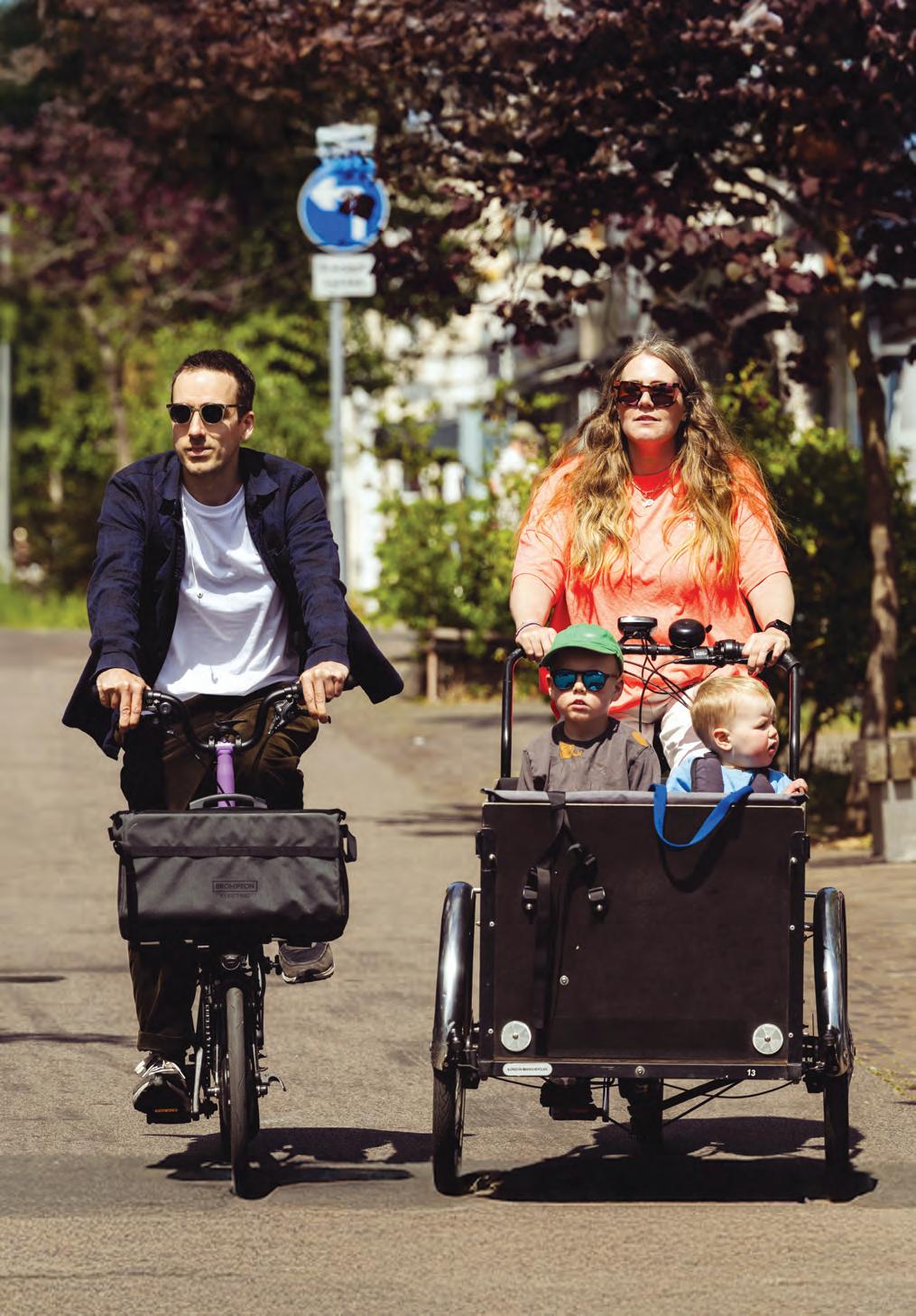
DARE TO DREAM CAMPAIGN


DARE TO DREAM CAMPAIGN
A BIKE FOR EVERY LONDONER
HOW TO BEAT CYCLE THEFT
LONDON’S BEST GRAVEL RIDE
COMMUNITY CYCLING PROJECTS
THE BEST URBAN E-BIKES

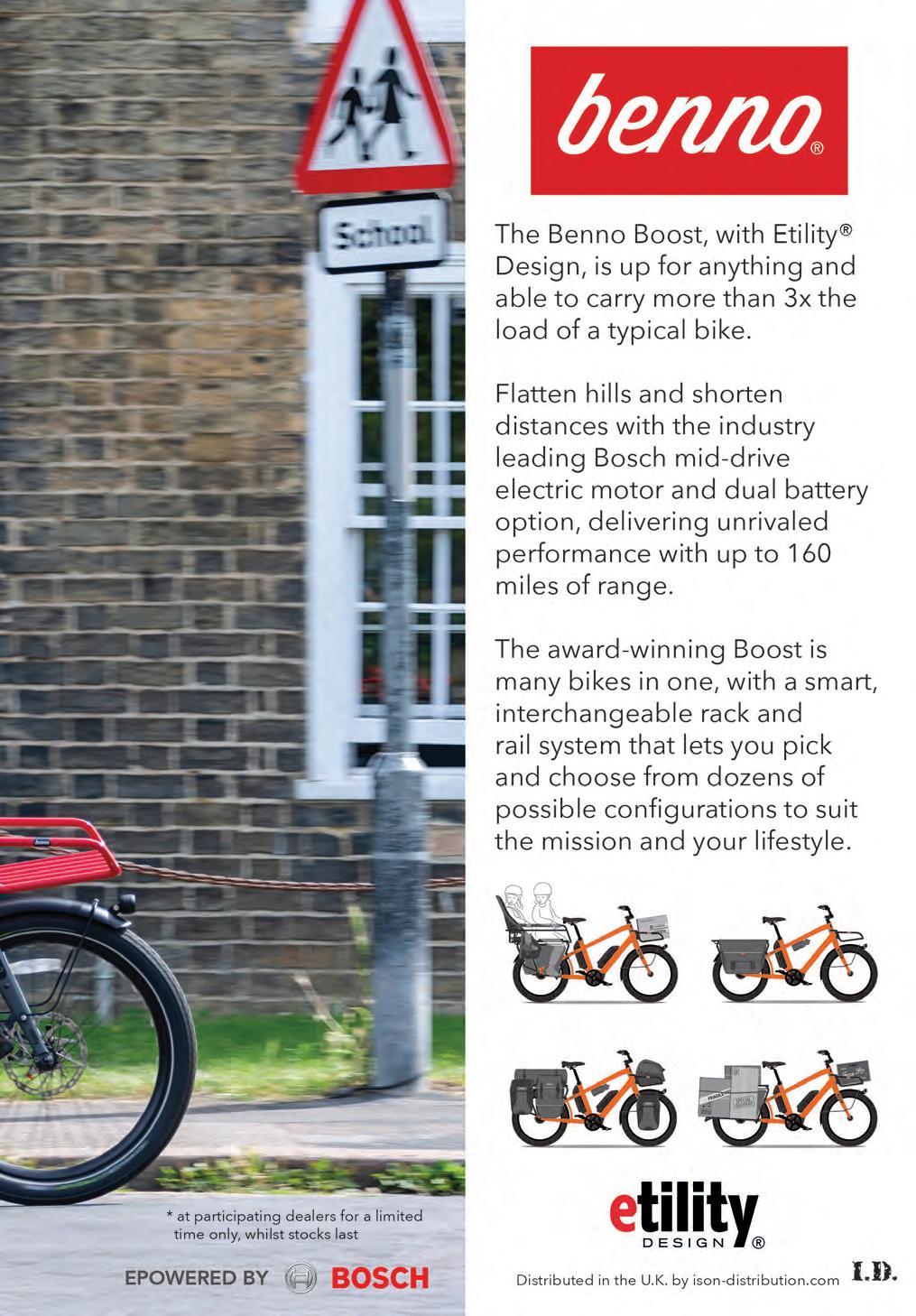


16 Dare to Dream: West End
Why London’s historic streets need to be redesigned for active travel
22 Interview
We meet the siblings getting underrepresented groups involved in cycling
28 Share the Joy: One Year On
See how additional funding is helping local community projects thrive
36 Cycle Theft
How we’d like the Mayor and police to tackle this damaging, growing crime
41 A Bike for Every Londoner
Smart initiatives that are reducing the barriers for new and returning cyclists
08 News
LCC’s board election, Shoreditch schemes, ‘floating bus stops’, and Urban Hill Climb
11 Opinion
Celebrating strategic partnerships, making changes, and why bikes are best
66 Iconic Bikes
Columbia’s Superb: a curvy, chromed cruiser that evokes rock ‘n’ roll nostalgia
52 Ride
Is this London’s best ‘gravel’ ride? Head west and follow our free map...
56 Advice
How to index your gears and ensure your drivetrain always runs smoothly
58 Reviews
Riese & Müller’s Load 75 and Tenways CGO009 tested, plus latest product news


Location: East London
Unit 206, The Record Hall, 16-16A Baldwin’s Gardens, London EC1N 7RJ n 020 7234 9310 n lcc.org.uk
EDITORIAL
HTIOW DO WE get more people cycling? It’s the million dollar question and a raison d’être for most active travel organisations around the world.
It’s also a question that has several inter-linked answers, a handful of which form the key strands of LCC’s new Dare to Dream campaign.
Research tells us safety is the number one barrier to cycling — no one wants to ride where it’s life-threateningly dangerous, where it’s intimidating or there’s a risk of personal harm. That’s where the calls for more car-free areas come from, hopefully developing out from frequent ‘Sunday Streets’ events. Likewise a traffic-free West End and town centres will invariably make things safer — and healthier, less polluted and more liveable — for cyclists, pedestrians and residents alike.
But what about a step further back, those people who want to cycle but don’t even have a bike? Or a secure place to store one? In this edition we meet a group of Londoners who are already benefitting from smart initiatives to remove these basic obstacles. With wider adoption, the concept of ‘A Bike for Every Londoner’ needn’t be a pipedream.
It’s also a year since Lime’s Share the Joy funding has been available for groups looking to expand cycling in their communities, so we find out how the latest lucky recipients are using their grants.
John Kitchiner Editor

Osbornes Law is the official legal partner of LCC, providing members with exclusive access to a legal helpline. If you’re involved in a collision or have a cycling-related legal issue, phone the cycling team at Osbornes for advice on 020 7681 8672.
Editor: John Kitchiner (london.cyclist@lcc.org.uk)
Design: Anita Razak
Contributors: Simon Munk, Tom Bogdanowicz, Sam Stephenson, Jessica Pike, Rob Eves, Tom Fyans, Charlie Codrington, Carlton Reid
ADVERTISING
Allie Gill (allie.gill@lcc.org.uk)
SOCIAL MEDIA
TWITTER: @london_cycling
FACEBOOK: @LondonCyclingCampaign
INSTAGRAM: @london_cycling_campaign
Editorial, copyright, membership
LCC is not aligned with any political party. All views expressed in London Cyclist are those of the authors and are not necessarily endorsed by the editor, nor do they necessarily reflect LCC policy. All material is copyrighted and may not be reproduced without the written permission of the editor. Editorial content is independent of advertising. All LCC membership offers and discounts are presented entirely at the discretion of the provider.
London Cyclist is published by LCC.
MORE INFO: lcc.org.uk
MEMBERSHIP: lcc.org.uk/membership TO DONATE: lcc.org.uk/donate
LCC is a charitable limited company, reg no 1766411; charity no 1115789
London Cyclist is printed by Buxton Press on FSC certified carbon-balanced paper from responsible sources.


LCC IS LOOKING for new trustees — there are five vacancies in this year’s election to the LCC board. Those elected will serve for three years (until the 2028 AGM).
The ten-strong board, elected by the membership, is responsible for governing the organisation. Trustees oversee the CEO and staff team, making sure we work towards our campaigning goals, meet our legal responsibilities and manage our finances well. If you’re passionate about cycling in London, we encourage you to stand. To do so, please complete and return a nomination form online at lcc.org.uk/board.
We’re especially keen to hear from you if you’ve never thought of yourself as a ‘typical’ board member. LCC is committed to becoming a more inclusive organisation, and we’re particularly keen to receive nominations from people from backgrounds currently underrepresented in cycling and on our board — including London’s diverse communities. No previous board or trustee experience is required, just your commitment and perspective.
You’ll need two fellow LCC members to nominate you, but if that feels like a barrier please do get in touch and we’ll support you. Candidates are asked to provide a supporting statement (500 words); examples from previous candidates are available at lcc.org.uk/board.
Want to chat before applying? We know that standing for election can feel like a big step, so if you’d like to find out more before deciding, have a read of the blog post at lcc.org.uk/board. You can also drop us a line at agm@lcc.org.uk and one of our current trustees will contact you for an informal chat.
Completed nomination forms must be returned to the LCC office by 9am on Monday 13 October 2025. Full details of how to do so are on the form.
This year’s AGM will take place at St Paul’s Church, Bedford Street, WC2E 9ED on Tuesday 25 November at 6.30pm. We will send more details in the autumn, but please make a note of the date for now.

in
Number of British riders in the 2025 Tour de France and Tour de France Femmes. A men’s record.

TFL HAS announced new plans for Shoreditch High Street, from the Great Eastern Street junction north to almost Old Street.
The good news? The scheme will be significantly safer for cycling north to south. It looks like TfL has been rattled by our recent ‘Too weak, Sadiq’ campaign — these designs are a lot better than the previous ones for the nearby Great Eastern Street/Curtain Road junction.
LCC RECENTLY helped head off an attempt in Parliament to remove ‘floating bus stops’ found along cycle tracks in London.
Several MPs, Lords and organisations representing visually-impaired people had argued these designs, where a cycle track goes around or behind the waiting area, are dangerous and a barrier to inclusive mobility.
From 2026, there will be zero freeto-air tv coverage of LeTourin the UK. Discovery now has tv rights.
The bad news? The scheme is still not safe enough at the nastiest junctions and certainly isn’t going to be comfortable enough for most women, children or new cyclists to ride. It may be better, but it’s still not great.
So we’re asking you to fill in the consultation today and tell TfL to remove all Healthy Streets ‘zero scores’, the worst fails in the scheme — there’s four in there, down from eight — and just make those junctions much safer and better for everyone. If it can be done in Waltham Forest and Newham, why can’t it be done here? n haveyoursay.tfl.gov.uk/shoreditch-high-street.

ON 27 SEPTEMBER, Swain’s Lane will once again play host to LCC’s Urban Hill Climb — the only such event in Greater London.
Whether it’s your first hill climb or you’re a veteran, anyone and everyone is welcome to come down and take on the challenge. And this year it won’t only be the quickest riders getting the plaudits, a new category — Best Dressed, in association with Altura — will see those participants who’ve been the most creative in their outfits be rewarded.
Don’t fancy taking on the climb with a road bike? Well there’s categories for e-bikes, folding bikes, cargobikes and more, the choice is yours. n lcc.org.uk/events/urban-hill-climb-2025.
However, LCC, active travel groups and engineering experts argue that evidence from TfL, and internationally, is these are broadly safe and not so hostile that visually-impaired people appear to be avoiding routes with them on. LCC also argued cycle tracks with gaps instead of floating bus stops aren’t cycle tracks, aren’t safe and don’t enable a wide range of people to cycle.
The government has since announced a temporary pause on one type of floating bus stop until better design guidance is out, but overall it recognised the evidence around, and need for, such schemes and cycle tracks.


As a way to celebrate LCC’s new strategic partnerships, this is a joint editorial with Lime’s Hal Stevenson
CYCLING DOWN the closed roads in Hoxton to join in the fun at Hackney’s Sunday Streets event in May, it was gratifying to see how many young families, including toddlers on balance bikes, had taken the opportunity to explore their community on two wheels.
The event was part of the inaugural London Festival of Cycling, organised by LCC and supported by Lime, which saw activities in over 20 boroughs. Thousands of people took part, with 27 led rides taking place across the city. It was really noticeable how many new people took part in these inclusive rides, with the majority never having participated in an LCC ride.
The festival was a one-off event, but on any day now you only need to go outside to see London’s cycling scene is buzzing. Active travel is becoming a vital part of our city’s rhythm, offering a healthier, faster and more fun way to navigate our vibrant streets. And if you look a little closer at London’s cyclists, you might notice they’re becoming more diverse too.
Gone are the days where socalled ‘MAMiLs’ (middle-aged men in Lycra) dominated the cycle lanes. In July, the British Heart Foundation (BHF) published new
data showing nearly half (44%) of UK women aged 34-60 now cycle, with almost a quarter (24%) eager to get started.
Shared e-bikes have been a key driver in this shift. Lime has brought over 800,000 new cyclists onto bikes in London. What’s more, 60% now cycle more often after their first ride. And behind these stats are real people with real stories from all backgrounds who are experiencing the positive impacts of cycling. It’s truly amazing to see how these e-bikes offer health benefits, getting folks moving and feeling better, and how they broaden access to cycling for those who might have thought it wasn’t for them.
From the 43-year-old rider who told us how Lime e-bikes have been a game-changer since his sciatica made riding his old manual bike near impossible. Another rider told us her cycling obsession began with her first Lime ride, bringing
“Now you only need to go outside to see London’s cycling scene is buzzing”

Tom Fyans Chief Executive of the London Cycling Campaign
back that childhood “feeling of freedom”. This led to her buying a bike of her own and becoming deeply involved in London’s cycling community, joining the Women of Colour Cycling Collective.
But despite how far we’ve come, there’s s still more work to be done to make sure every Londoner feels like they belong in the cycling community. That’s why we’re so proud of our joint Share the Joy community cycling fund. This initiative awards grants to projects that genuinely encourage more people to cycle, focusing on areas like health and wellbeing, accessibility and inclusion, and skills and connectivity. The fund prioritises projects that support groups often underrepresented in cycling, or those that might struggle to access funding from elsewhere. So far, we’ve donated more than £160,000 to over 58 community organisations, and we’re just getting started.
The latest funding round for Share the Joy has just closed, but we’ll be running further rounds later this year and into 2026 as part of our London Action Plan. Together, we’re proud to play a role in helping these important organisations grow and building a more inclusive, joyful cycling culture across our city.


To make transformational change, says Natalie Lindsay, we need to challenge emotion with rational analysis
WHY DO changes to our urban environment generate so much anxiety and hostility even though we know the present status quo is failing us? And when we also know, from decades of research, that once changes are established people love them and will not go back.
Yet each time any manipulation of our urban environment occurs the ‘hill of hysteria’ kicks in. As an active travel campaigner, I wrote a blog (tinyurl.com/hillofhysteria) seeking to explain, in lay terms, why change to the urban landscape is so contentious and why each and every one of us must work with ourselves to overcome our psychological brainwashing.
Accepting change is hard. Accepting change to the way we live and the place we care about most, our local environment, generates a very personal and often visceral reaction. As humans we are programmed to accept the environment that we live in as being normal — what we know, and experience, is integrated into our psyche. This is known in scientific terms as ‘baseline syndrome’ (tinyurl.com/baselinesyndrome) and is the fundamental reason why we struggle to understand the disastrous state of our environment
and the urgency to act, because we cannot see what we have lost.
We witness a few insects in the garden, the odd dead bug on a windscreen and assume that that is normal. Yet we have lost 70% of the volume of insects over the last decades with disastrous consequences to the ecosystem, from bird numbers to our ability to grow food. However, we are unaware of this year-on-year decline precisely because it is not immediately visible. We all assume that our current experience of our environment is normal because it is what we ‘see’.
The way we live, the way we move, is subject to the same baseline syndrome. We have devised a civic space that prioritises the use of the individual car, so using a car has become part of our psyche. For many it is all they have ever known: driven to school, passed driving test, bought a car, driven own kids to school. And because we cannot
“As humans we are programmed to accept the environment that we live in as normal”

envisage what we cannot see — a car-light society — we excuse the dangers of vehicles.
Psychologists have done fascinating work demonstrating how we excuse ourselves and our behaviour when in a car and the double standards we apply. It’s referred to as ‘motornormativity’.
As a society we’re addicted to cars. And like all true addicts we struggle to even admit or see that we have an addiction, and as a result we constantly seek to excuse our fellow addicts — because, hey, that could be me! And because changes to the urban realm potentially impact this addiction the hostility to any proposed redesign can be, well, hysterical.

So whether it is a redesign of a main road, separated cycle lanes or LTNs, for many of us the proposed changes trigger an emotional reaction based on our inability to ‘see’ an alternative to the status quo and a sense of outrage that our way of life (our addiction) is being somehow attacked.
The challenge to society is to accept that our innate hostility to change is based on emotion not reason, addiction not rational analysis and that ultimately the transformation of our urban realm can be positive for us and our families. Give change a chance.
Even in the fast-moving world of transport tech, Carlton Reid believes nothing beats a humble bicycle
TECH PUBLICATION
Wired has beaten a lot of traditional media to important US political stories — such as identifying there was a youngster known as ‘Big Balls’ working for Elon Musk in the jobs-slashing Department of Government Efficiency — and I’m doing my little bit from here in Blighty by penning critiques of the preposterous Cybertruck among other things.
While I’ve also contributed pieces on spacestation design and iPhones, writing so many articles on Musk has turned this cycling journalist into a motoring one. I now get to see up close and personal some of the latest advancements in automotive technology, such as the chase to make cars driverless and, before that supposed nirvana, the improvements being made to advanced driving assistance systems (ADAS), including the detection of pedestrians and cyclists.
As a long-time champion of walking and cycling as transport, I’m able to quiz car companies from the point of view of those being detected, something that has often surprised the technicians I interview. I’ve sometimes even taken my Brompton along so I can hop on and test this cyclist detection tech in real-time.
On the whole, I’ve been impressed with the motivations of those working on such tech — there seems to be a genuine desire to save lives rather than just boost car speeds — and those companies which equip their cars with the latest and best sensors could, in time, genuinely make it safer out there for those on foot or biking.
Companies that prioritise safety on the cheap — eg, by ditching lidar sensors due to the expense — are, thankfully, losing sales, and not just because of the questionable politics and arm-thrusts of their leaders. Meanwhile, China — once known as the ‘bicycle kingdom’ — has become the world’s largest and most advanced automotive market, with ADAS and other technologies on even affordable Chinese cars far outstripping what is commercially available elsewhere.
But the tech bros who have long claimed that driverless cars will lead to significantly reduced streetside
“Then as now, cycling will remain the quickest way to get around town”

Carlton Reid is a book author and leading transport journalist
parking and less traffic congestion — because these robot-driven cars can skedaddle when not needed — are wrong. If anything, such vehicles will induce more journeys, and traffic congestion will increase. Such a future poses a threat to public transport (why get on a bus with lots of others when you can hop on a cheap, door-to-door, personal shuttle?), but it also poses a threat to cycling. Making motoring ever more effortless can only enhance its amenity and, therefore, its appeal. Longer journeys, caused by congestion, will become more readily accepted, mainly because of the potential for more nose-toscreen time.
Then as now, cycling will remain the quickest way to get around town, which should be something in its favour. But you can’t (or at least shouldn’t) doomscroll while pedalling, thereby reducing cycling’s amenity in a screen age.
One key thing I have learned to appreciate even more than when I was a cycling-specific writer is the bicycle’s beautiful simplicity. While other augmentative machines become ever more complex, the form and functionality of the basic bike is so perfect that this relatively simple piece of low-tech design will far outlive other, supposedly more advanced technologies.

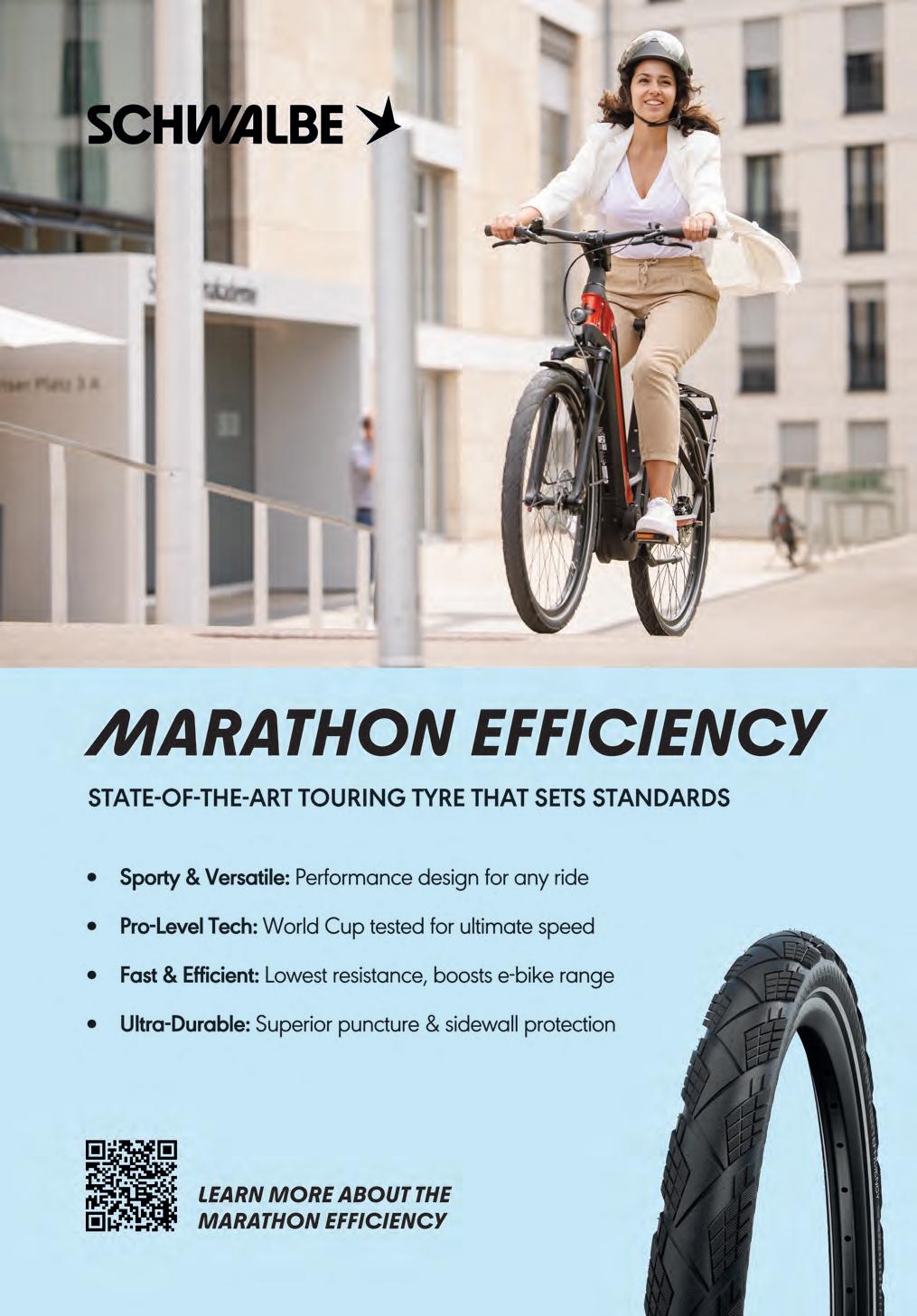
It’s long past time the West End went low traffic. Clare Hinchcliffe and Simon Munk explain the last strand of LCC’s Dare to Dream campaign
LCC’S DARE To Dream campaign is all about asking Mayor Sadiq Khan to use what is likely to be his last term not to press backside to laurels, but to blaze a path forward for London and active travel, and leave a lasting legacy across the city for good.
We’ve already covered the campaign’s other strands on addressing cycle ownership and storage (A Bike For Every
Londoner), on delivering carfree monthly streets (see also our London Cycling Festival), and on fixing car-dominated outer London town centres so they’re far more family-friendly. You can check for updates on the website at: lcc.org.uk/dream.
The last and perhaps boldest strand of the campaign is asking for a low-traffic West End. Delivering real change in the West End has been overdue for decades, as successive mayors

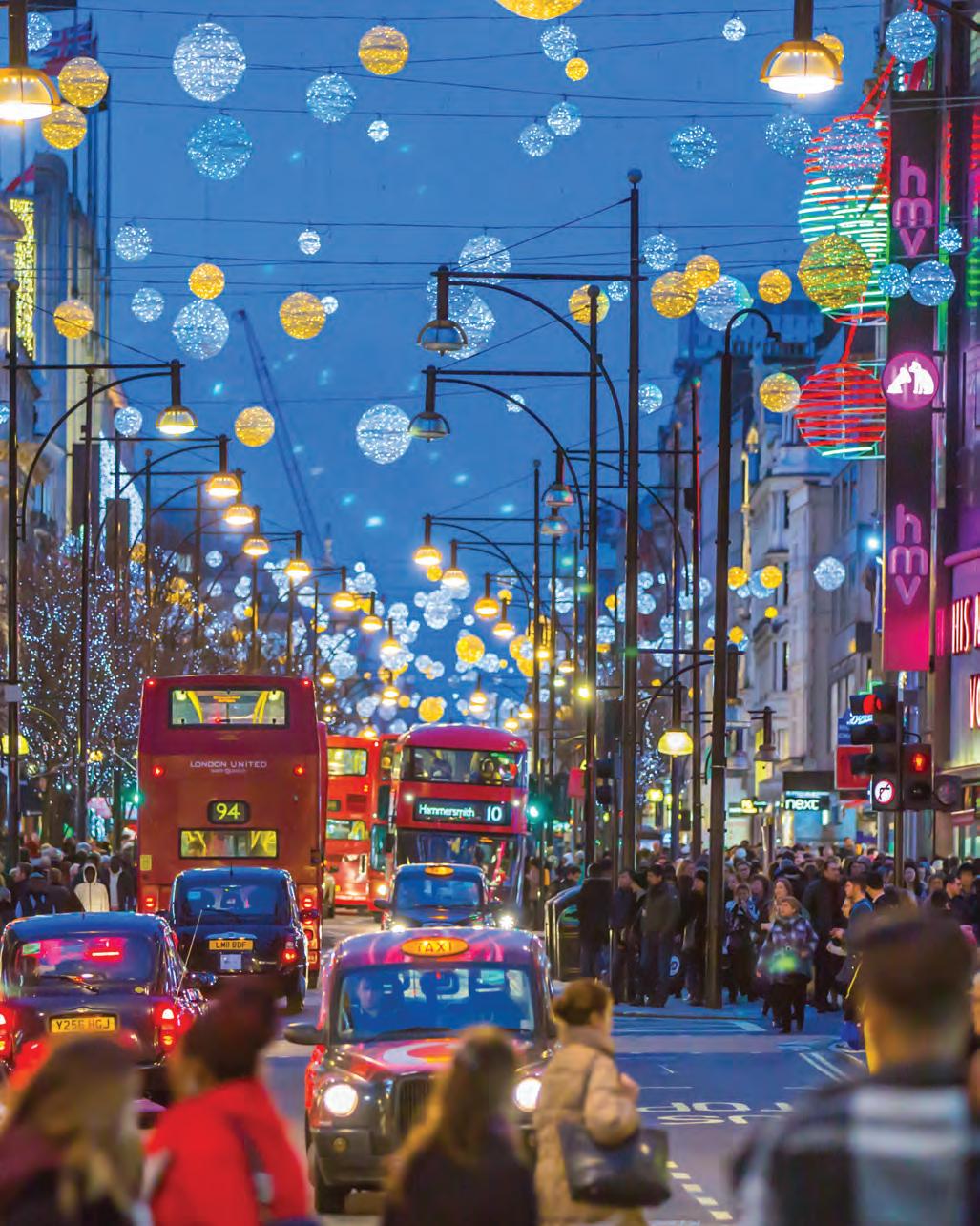
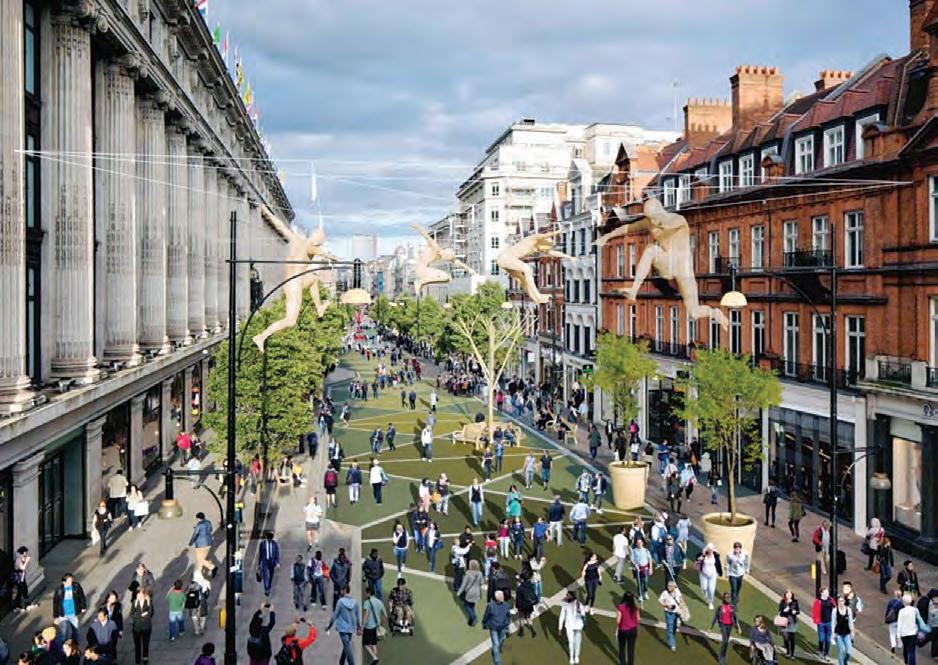
unlock more progress and potential to act than has been available before.
As part of the Dare to Dream campaign we’ve spent the last six months in secret working on a major report on how the Mayor might reduce motor traffic across the West End — making the case for why that’s not only obviously desirable but also necessary, and considering what other global cities are doing when faced with similar challenges and opportunities, and the results of their actions.
Before we summarise the report’s main points, it’s worth talking about one other small issue: cycling. The Mayor has already said his aim is not to allow cycling on Oxford Street.
Our view is that he could and should consider a cycle track — other major cities manage pedestrianised shopping streets
with cycling permitted. More, if the Mayor doesn’t enable cycling really well with close-by, parallel, direct, high-capacity and safe cycle routes, then he’ll continue to see people trying to cycle on Oxford Street despite a ban — which no one wants.
Our view is that given the wiggly, narrow streets either side of Oxford Street, a lowtraffic solution for the areas immediately bounding this key thoroughfare is the only likely way we, Westminster Council, etc can ensure cycling amenity, priority and permeability. A low-traffic West End is right for businesses, right for people walking and wheeling, it’s right for the area. But yes, it’s also right for cycling.
A low-traffic West End is simultaneously a bold and brilliant ask and also a no-brainer. The
West End is a globally-recognised destination for tourism, culture and retail, and an economic powerhouse — but motor traffic dominates most of its historic streets, while people are shoved to the side. And there has been loads of hand-wringing for far too long on the ‘relevance’ of the West End in an online world and where the competition for retail, cultural attractions and workplaces has never been hotter.
Soho, for instance, should be an idyllic place to visit, or work or live, with its walkable scale and narrow, historic roads. However, the sheer volume of motor vehicles in the area is both stressful and downright dangerous. And there’s clear signs that Soho is struggling to remain the iconic locale it’s been in the past, in part due to an organised local residents’ society that objects to just about any changes to ‘their’ streets.

During the Covid lockdowns, Westminster Council enabled al fresco dining. The scheme wasn’t well thought through and faced huge anger from residents, but the results also clearly demonstrated a huge appetite for Soho and removing the motor traffic there. Yet at the end of the social distancing period, the council cancelled the scheme and the new administration (having switched from Conservative to Labour) has since then repeatedly talked down the potential and focused on the antisocial behaviour that came with it.
Of course, residents in Soho, as with anywhere, deserve not to have their doorsteps urinated on, or to suffer antisocial revelry late into the night. But by return, Soho as an area won’t survive if all that remains is residents in flats, while revellers are asked to put up with crowded pavements and non-stop motorbikes, taxis and cars cutting through at speed.
And there are ways and means to make this work better all round. It seems facile to suggest that better enforcement, a betterdesigned scheme and real council and business leadership pulling together could unlock a very different and more ‘European’ Soho.
The future’s already here
There are already plenty of examples inside the area, and on its periphery, that demonstrate what applying low-traffic approaches to the West End might look like and how they can work successfully. And it’s interesting that vocal residents on both sides of Oxford Street never talk about them.

To the east, in the City, there’s ‘bus gate’ schemes such as the ones at Bank and Bishopsgate that demonstrably enable deliveries and access ‘out of hours’, but which have dramatically improved the streetscape for pedestrians in particular and for those just wanting to sit, chat and eat lunch.
Closer by, there’s several parts of Camden’s ‘West End project’ on Tottenham Court Road and around Shaftesbury Avenue that have removed large amounts of throughtraffic from the area, as have the separate Seven Dials’ changes.
Indeed, in Westminster and the West End, you can look at older changes to Leicester Square, Carnaby Street, the north side of Trafalgar Square, Gerrard Street, Lisle Street and the bottom end of Wardour Street, and more recently the Strand where it parallels Aldwych. Strand now stands as an exemplar of how a traffic-free streetscape can attract Londoners and tourists alike, without, it seems, massive amounts of antisocial behaviour.
These examples show that removing or reducing traffic has multiple benefits and that fears of disaster don’t materialise — who
now would want vehicles back in any of those locations?
So the West End is already a lowtraffic work in progress, though that is partly the issue here. The Mayor’s scheme for part of Oxford Street and newly-announced plans for Regent Street and Piccadilly Circus all represent the Mayor, Westminster Council and landowners such as The Crown Estate chipping away at the traffic in piecemeal fashion. But without a masterplan and vision for the area, each scheme increasingly risks pushing traffic into the next street over, and each scheme risks delaying the next one, particularly as residents increasingly voice their concerns about these isolated changes happening on top of them.
Instead, our report recommends the Mayor and stakeholders do what should have been done a long time ago and really sit down to hammer out a way to tackle the entire West End and as much of the motor traffic as possible. That would ensure a coherent approach, tackling all the traffic issues, plus it would potentially open up opportunities for innovation such as last-mile delivery, service consolidation and more. And it would likely help bring some residents on side, if it wasn’t just about pushing traffic from one nearby street to another.
One of the key reasons for this is that London doesn’t just have internal examples that show how this can be done, it also has internal

threats to the West End — with shoppers, retail and employers increasingly moving away from overcrowded pavements to nicer environments like the two carfree Westfields, King’s Cross, east London and other locations. London has no shortage of places ready and keen to benefit from the Mayor and council’s dithering over how to revive the West End.
Moreover, London as a whole has both examples and threats in the form of other global cities, ones showing how low-traffic schemes can reshape historic central districts, and proving it can be done faster and better. As current chair of the influential C40 Cities group, Khan has the chance to now mirror his bold fellow leaders.
In the eight years since the Mayor first mooted changes to Oxford Street, the residents of Ghent have been enjoying healthier, low-traffic streets since a ‘circulation plan’ was enacted to remove through-traffic in the city centre — over an area approximately 60% larger than the entire West End.
Ghent is hardly a global megacity of the same standing as
London though. For that, you have to look to Paris. Paris enacted its plan for a ‘Limited Traffic Zone’, that is basically the same size as the West End, in November last year (although fines don’t start until this September). The Zone à Trafic Limité (ZTL) sits on the north bank of the Seine in central Paris and acts in a similar way to Ghent’s circulation plan (or a giant low-traffic neighbourhood). You can enter in, even to shop, but you cannot drive through — in that case you have to drive round.
Paris, of course, is not alone. Barcelona’s megablocks (superilla), Krakow’s pedestrianised centre, Rome’s Via dei Fori Imperiali and more, all represent ways forward for London to follow alongside its own examples — in terms of understanding how to enable ambling, eating and cycling while also enabling servicing, deliveries, construction to continue in living cities. But while Paris, Barcelona, Rome and other cities civilise their busy centres by reducing traffic and giving priority back to people, London really risks falling behind.
Post-Brexit, London can ill afford that, particularly in areas
such as retail and hospitality. But more, it is striking that our report even needed writing. It is clear and evident that when loads of global cities are not only following London’s long lead on reducing motor-traffic in the city centre, but streaking past us, there increasingly seems little good reason or need for much of the traffic in our centre to be there.
Yes, we need construction lorries and we’ll need vans for the near future for business, retail and home deliveries. But so much of the traffic in the West End simply isn’t that — just as so many new schemes in global cities are demonstrating amply. We face two futures: one where we take bold action on climate emissions, pollution, inactivity, road danger, community cohesion, retail vibrancy and more, and one where we find ever-dwindling excuses to push back change another year, Mayor Khan and Westminster, which is it to be?
Change invariably stirs up controversy and opposition. But the case to not only support the Mayor’s Oxford Street proposals in the short term, but for a far wider and bolder transformation of the entire area — including Soho and other neighbourhoods — is basically irrefutable. For the benefit of residents, businesses, and London more widely, we’re asking the Mayor to Dare to Dream of a low-traffic West End. Then take concrete steps to make it a reality.
n For more info on the Dare to Dream campaign head to lcc.org.uk/dream.
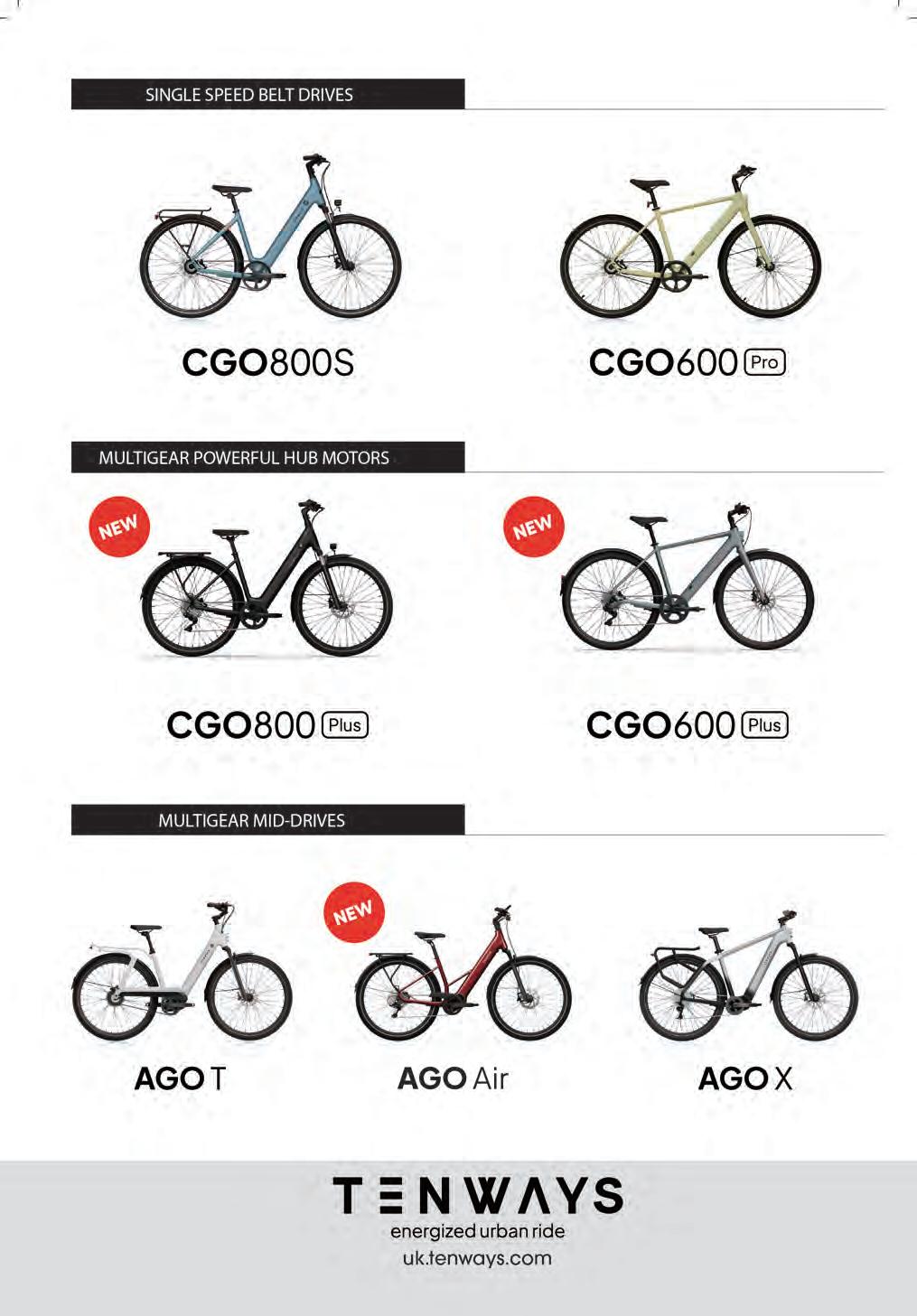
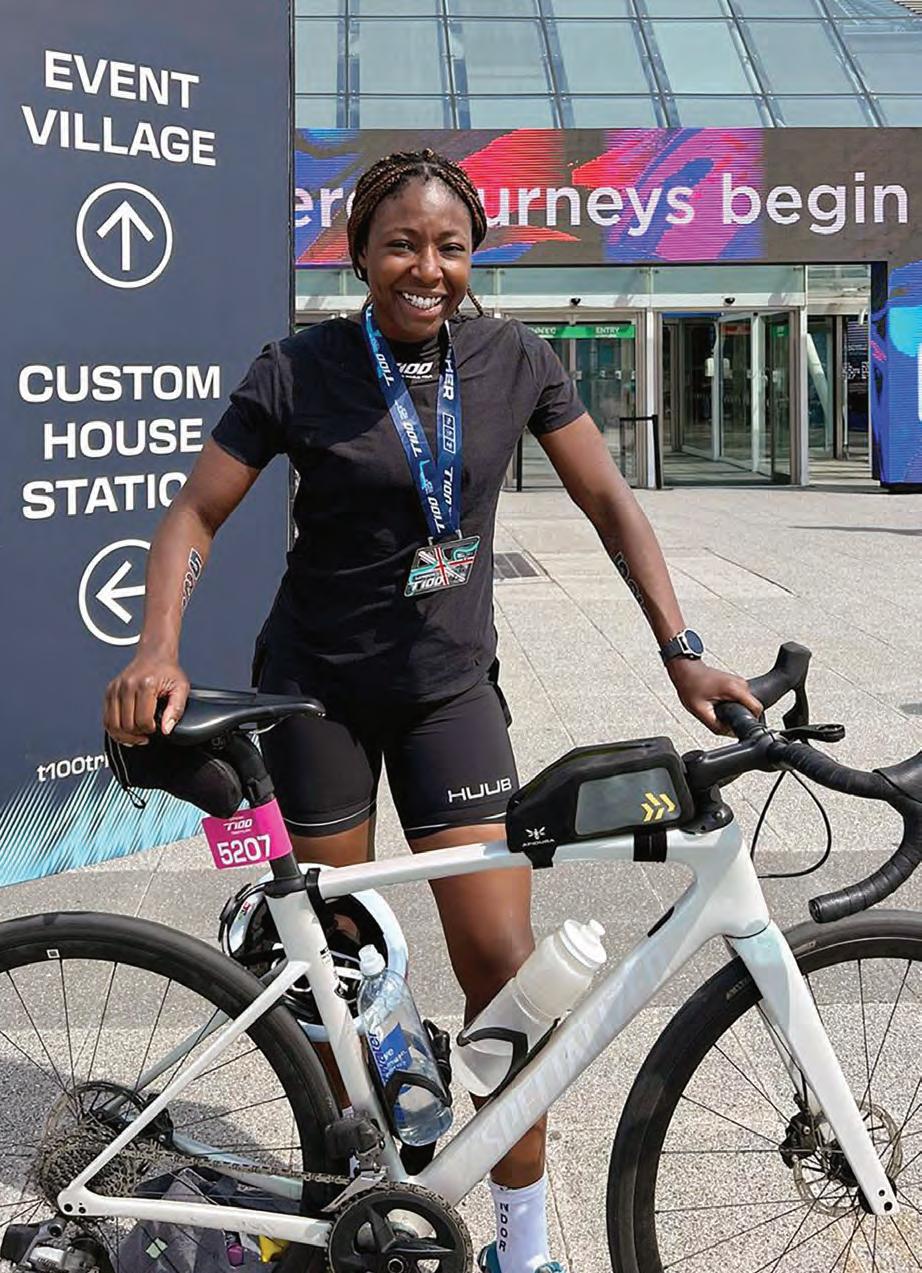
John Kitchiner speaks with the London siblings who are aiming to make cycling more inclusive and starting a first-of-its-kind prison initiative
For those unfamiliar with Cycle Together and its work, can you describe the types of services and activities that you offer?
Biola: Cycle Together is all about making cycling accessible and inclusive for everyone. We run a range of programmes and services aimed at breaking down barriers to cycling. For example, we offer free or low-cost cycling courses, both online and in person, for beginners and intermediate riders. These include guided group rides, hands-on bike maintenance workshops, and confidence-building training sessions.
We’ve also built an online resource hub and support community, a kind of one-stop shop with articles, video tutorials and forums where people can ask questions and get encouragement. Plus we have initiatives like our women’s prison programme.
When and how was the organisation founded? Where did the idea come from?
Biola: We officially launched in 2021/22, but the idea had been brewing for a while before that. It actually came from my experiences in my cycling club post-lockdown; I noticed a lot of new people (many of them women and people of colour like me) were getting into cycling, but were nervous about joining traditional clubs. They’d say things like, “I’m not sure I’m fit enough”, or “I don’t know if I’ll fit in.”
Powerhouse of Cycle Together: Biola (left) at last year’s London T100
And I realised, if you don’t have a friend to bring you into a cycling group, it’s really hard to take that first step. I remember thinking it was such a shame that there wasn’t a way to bridge that gap.
Kunle: I vividly recall Biola talking about this idea a few years ago, and I was completely on board. We never imagined as kids that we’d start a business together, but when she told me her vision I thought I definitely want to be part of it. So we took the plunge and co-founded Cycle Together.
In the cycling world, it’s quite uncommon to find initiatives set up by siblings, so what was each of your backgrounds in cycling or other work that influenced your thoughts on starting Cycle Together?
Biola: I’m a born-and-bred south Londoner, but funnily enough I only got serious about cycling in my adult life. By profession I’m an economist, so I brought a bit of a business and analytical mindset to this. My cycling journey started when I joined Velociposse, an all-women’s cycling club in London. I eventually became chair of that club for three years, and under my and the committee’s tenure the membership literally quadrupled. That experience was huge for me. It gave me first-hand insight into the challenges people (especially women) face when trying to get into cycling.
I also got involved with the Women of Colour Cycling Collective and became a qualified British Cycling coach during that time. Through those efforts, I learned how much representation and supportive coaching matter; marginalised groups can thrive in sport when given the right environment.
Kunle: My path is a bit different. I’ve been working as a surgeon in the NHS for several years, and also serve as a clinical safety officer focusing on digital health tech. So from the career side, I’m coming at this from
a health and research angle. I’ve always loved staying active (I do a bit of cycling, and a lot of hiking and running), but what really influenced me was seeing the health disparities in my medical practice.
We know that only about one-fifth of adults in the UK cycle regularly, which means a huge portion of the population is missing out on the health benefits of cycling. As a doctor, that stuck with me. There’s so much evidence that regular exercise can prevent chronic diseases — for instance, if people over 55 exercise more, it can reduce their risk of developing type 2 diabetes by around 40%, not to mention lowering risks of heart disease and some cancers. And it’s not just physical health; I’ve delved into research on mental health and found that cycling and other physical activity significantly reduce anxiety and improve mood by cutting down stress hormones in the body.
Also, I’m leading our partnership with Loughborough University where we research sport-based interventions, basically studying how programmes like ours can improve health and how to get more people active. So my background in medicine and research directly shapes how we design Cycle Together’s courses (grounded in health evidence) and how we measure success.
How do you manage the day-to-day operations and divide up the workload between you?
Biola: Ha, with great difficulty and a lot of sibling honesty! We’re very close as brother and sister, which helps, there’s what I call ‘radical candour’ between us. I handle a lot of the operational side: coordinating our programmes, dealing with partnerships and sponsors, managing budgets, and generally keeping the wheels turning.
Medical
insight: Kunle brings his NHS know-how and research skills to the project
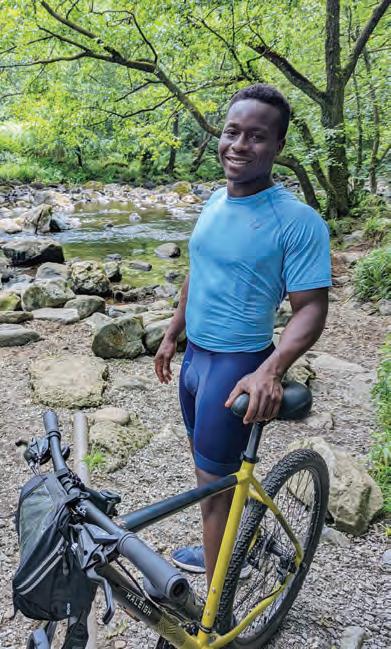
brutally efficient; if I think something isn’t working, I tell Biola straight away and vice versa, and we fix it.
Biola, you’ve mentioned being involved with the Women of Colour Cycling Collective — presumably that gave you further insight into the role cycling can play in under-represented groups?
With the Share the Joy funding, we’ve implemented a cycling programme inside HMP Downview
Kunle: And I’m essentially wearing two hats, my NHS work and then Cycle Together on evenings and weekends. We divide and conquer based on our strengths; Biola is definitely the powerhouse on daily logistics, and I’m more in a support role focusing on research and big-picture strategy. The great thing about working with your sibling is you can be
Absolutely. It was eye-opening and inspiring. When you ride with a group of women of colour, you immediately feel the difference in energy and understanding, there’s this shared experience of being a minority in a very traditionally white, male cycling world. Through the collective, I heard so many stories of women who, before finding that group, felt cycling wasn’t for people like them. But once we were together, cycling became a source of joy, empowerment and sisterhood. It really drove home for me how important it is to see people who look like you in a space.
I often say cycling is for everyone, but my time with WCCC made me live that truth and want to bring it to life on a larger scale.
Kunle, can you explain more about the Loughborough University partnership and what you hope to demonstrate?
Kunle: Our partnership is all about adding a robust research element to what we’re doing on the ground. We want to not only run programmes, but also study them and learn from them. In practice, this means we’re collaborating with Loughborough’s sports science and behavioral science researchers to evaluate the impact of Cycle Together’s initiatives and to explore how to scale them effectively. One part of the project is identifying the barriers that keep certain groups from cycling, in a data-driven way.
We obviously had our own experiences and intuitions, but it’s important to get rigorous data. So, for example, we conduct surveys and interviews with participants and even people who didn’t finish our courses, to understand what challenges they faced. Another aspect is measuring outcomes. We’ve set up a framework to track things like participants’ physical health metrics (maybe simple ones like self-reported fitness), their mental wellbeing scores, and their social connectivity (like, did they make friends or join a club) over the duration of a programme. We want to produce evidence of what works.
Typically community cycling initiatives don’t come paired with academic research, so it’s quite pioneering, a kind of ‘living lab’. Our hope is to publish those findings, or at least share them, so other communities can replicate our success.
Cycle Together was recently awarded a Share the Joy grant — what will the funding be used for?
Biola: The grant has been a fantastic boost for us, and we’ve dedicated it entirely to expanding our women in prisons project. Women in prison

First of its kind: Cycle Together’s new women in prison programme is up and running in London
typically have very poor physical and mental health outcomes, and they’re often forgotten about in these kinds of initiatives, and we wanted to change that. With the Share the Joy funding, we’ve implemented a cycling programme inside HMP Downview (a women’s prison in south London).
The focus is twofold: first, simply giving the women the chance to get on a bike and experience that sense of freedom and fun, even within the confines of prison. We do basic cycle training starting with balance and pedalling, building up to small group rides around the yard. It’s amazing how even a short spin can light up someone’s day in that environment. The second part is teaching them basic cycle maintenance skills. This is really important to us. Many of these women will be looking for employment after release, and we know lack of job skills and opportunities is a big factor in reoffending. By giving them some hands-on training we’re aiming to improve their employability. Just having that skillset can boost confidence and it’s something constructive they can take pride in.
Are you hoping to expand the prisons project wider?
Biola: HMP Downview has essentially become a model site for us. We’ve built a relationship with the prison staff and understand all the security protocols and logistics. The partnership there has been really encouraging and the prison’s management and women’s custodial services group have been very supportive. They helped us get the bikes and equipment in, and they’ve been working with us to schedule sessions in a way that fits the prison routine.
But we do have ambitions to take the programme to other facilities and we’re already in conversations with a couple of other prisons. And we’re also exploring working with probation services as a next
step, basically supporting women after they leave prison, to continue cycling on the outside. But ‘expansion’ isn’t just about new prison sites, it’s also about the continuity of support.
Is it too early to assess the likely impact of the extra Share the Joy funding, or what goals have you set?
Biola: We are still in the early stages of the prisons project, but we do have some clear goals. Broadly, we’ve set out several key outcomes we want to achieve: improved physical health and mental wellbeing for the participants; increased confidence and sense of connection; and tangible skills gained (like bike maintenance know-how and teamwork skills). In terms of participants, we’re running several cohorts of about 8-10 women at a time, over multiple weeks each.
We also outlined what success looks like in qualitative terms. For instance, we’d love to see reductions in reported loneliness and anxiety among the participants. Cycling can be a tool to reduce loneliness and increase confidence, even in prison. We’re hoping to see improved relationships between inmates and staff as well; when staff get involved cheering someone learning to ride, it humanises both sides and can promote a more positive atmosphere. And, of course, from a health perspective, we’d like to see the women feeling fitter or more energetic.
We’re measuring impact in a few ways. We have the women fill out short surveys (anonymously) before and after the programme, asking about their mood, confidence, and whether they intend to continue cycling. We also track fitness in a rudimentary way (some could barely manage a few minutes on the bike at first, and we see them improve over weeks). Thus far, even though it’s early, the feedback has been wonderful.
We’ve set goals like: at least 75%

Cycling in prisons?
You’d better believe it, and the impact has been nothing but positive
of participants reporting improved wellbeing and 75% demonstrating one new skill (like fixing a flat tyre). So, while it’s a bit soon for final results, we’re definitely not flying blind.
Biola: Gosh, there have been so many moments that have made me proud. One big highlight for me was the completion of our very first 12-week beginner programme in 2024. We had a cohort of participants who were mostly complete novices at the start, and by the end the transformation in them was incredible; every single participant reported improvements in their mental wellbeing and confidence, and all of them wanted to continue cycling after the programme. We even had a celebration ride at the end where they all wore matching Cycle Together jerseys, and it was just pure joy.
Another highlight was receiving a community grant from the Brockwell Live Fund. We’re a small organisation, so to have others believe in our mission enough to fund us, that was validation that we’re doing something important.
Kunle: I’d echo a lot of what Biola said. For me, a particularly special highlight has been launching our women’s prisons programme this year. It’s the kind of project that hadn’t really been tried before, bringing cycling into a prison, and I remember on the first day of the programme not quite knowing what to expect. But by the end the participants were smiling and saying they couldn’t wait for the next session. During an event at the prison, one of the women told us: “Cycling could help me feel normal again, something I can keep doing even after I leave here.” It hit home that this is more than just riding bikes — it’s giving people hope and a sense of freedom.
Another highlight has been seeing the wider cycling community get behind us. Whether it’s been Specialized sponsoring our beginner programmes, or support from Balfe’s Bikes, each has opened new doors to show what we can offer our participants.


Sam Stephenson meets a handful of the latest groups to win funding and finds out how they’re growing cycling locally
IT’S BEEN ONE year since LCC, Lime and Loud Mobility came together to create Share the Joy. A fund with the sole purpose of awarding grants to community cycling projects, to help as many people as possible get out on a bike and enjoy the benefits of cycling.
While the quick way of showing the impact of the fund would be to rattle off some statistics — more than £160,000 awarded to over 58 community projects, for example — we thought it would be better to catch-up with some of the groups who’ve received funding over the past 12 months.
From helping women in prison to get back on a bike, to giving homeless people the skills to find employment as cycle mechanics, Share the Joy has already helped countless Londoners in so many different ways. For those who want to cycle, but have found access a challenge, perhaps because of a disability, or financial difficulties, Share the Joy groups have been the ones stepping up to bridge that gap.
It’s not just major projects that this funding has been put towards either. For many groups the money has been used to cover core costs, and elsewhere it’s proved to be the spark to bring other long-term cycle plans to life.
And, brilliantly, a large number of grant recipients who’ve been running successful initiatives in their communities for some time have now been able to move things to the next level, be that through increasing the number of people they can reach, or in the cycling services they’re able to provide.
So let’s meet a few more of London’s thriving cycle groups...
Name: Paul Haig (secretary) Borough: across London
Could you give us an overview of the history of the Sikh Cycling Club (SCC), and how it all started?
The Sikh Cycling Club was formed in 2012 by a small group of like-minded individuals who shared a love of cycling and a passion for community. What began as informal weekend rides soon grew into a structured club inspired by the Sikh values of seva (selfless service), sangat (community), and chardi kala (positive spirit).
What have been some of your personal highlights from your time being involved?
Simply watching new riders progress, from nervously joining their first level one ride to confidently completing
50-mile challenges. Seeing that growth first-hand is incredibly fulfilling.
But above all, seeing the camaraderie between riders; someone stopping to help with a puncture, or cheering each other home at the end of a long day. That spirit of seva and support is truly special.
What will the Share the Joy funding be put towards?
It will be instrumental in developing our ride leadership programme. Specifically, we’ll use the grant to book a private British Cycling level one course. This will help train a new wave of confident and competent ride leaders, equipped to lead groups safely through urban and rural environments (up to 50 miles).
And the potential impact of the fund? Even before the course takes place,

the fund has already delivered tangible benefits. We can now confidently plan more frequent and diverse rides, especially for underrepresented riders, women and new cyclists.
Beyond that, from a club sustainability point, this investment will create long-term value, enabling us to grow responsibly and inclusively.
What would you say to other organisations that are thinking of applying for funding?
The Share the Joy fund is more than just a grant, it’s a vote of confidence in your community. It gave us the structure and support to move from an idea (leadership training) to action (a booked course and committed volunteers). It’s an enabler — for your members, your mission and the wider cycling community.
Name: Poppy (co-founder)
Borough: Hackney
Can you tell us briefly how Broad Bikez got started?
We started in August 2021. There were three of us at first: me, Eve and Anna. At the time me and Eve were seeing first-hand how female mechanics were treated in the industry, and started doing some research about people’s experience of going into bike shops. And a lot of people were saying how they didn’t feel like it was a space for them, as female or LGBTQ+. So we started doing our own workshops, marketed to female and LGBTQ+ cyclists.
What have been some of your personal highlights so far?
Moving into our own space is the highlight. It’s right in the middle of three large estates, so we get a lot of residents, particularly young ones, bringing their bikes in or using the workshop.
What are you putting the Share the Joy funding towards?
We’re doing about four workshops a month, which the fund goes directly towards, either by paying staff or providing the equipment needed. With everything going on right now politically with the trans community, we’re also using the funding to make classes free for trans individuals. Plus we’ve also used a bit to market ourselves more, to get more people through the door.
And the impact of the grant? It’s been massive. We’ve gone from a small group with just us three volunteers to a point where, thanks to Share the Joy, we can now take a very small salary and pay our mechanics for their time.
And your advice to other organisations thinking of applying?
Do it! It’s 100% worth it, and it’s so straightforward.
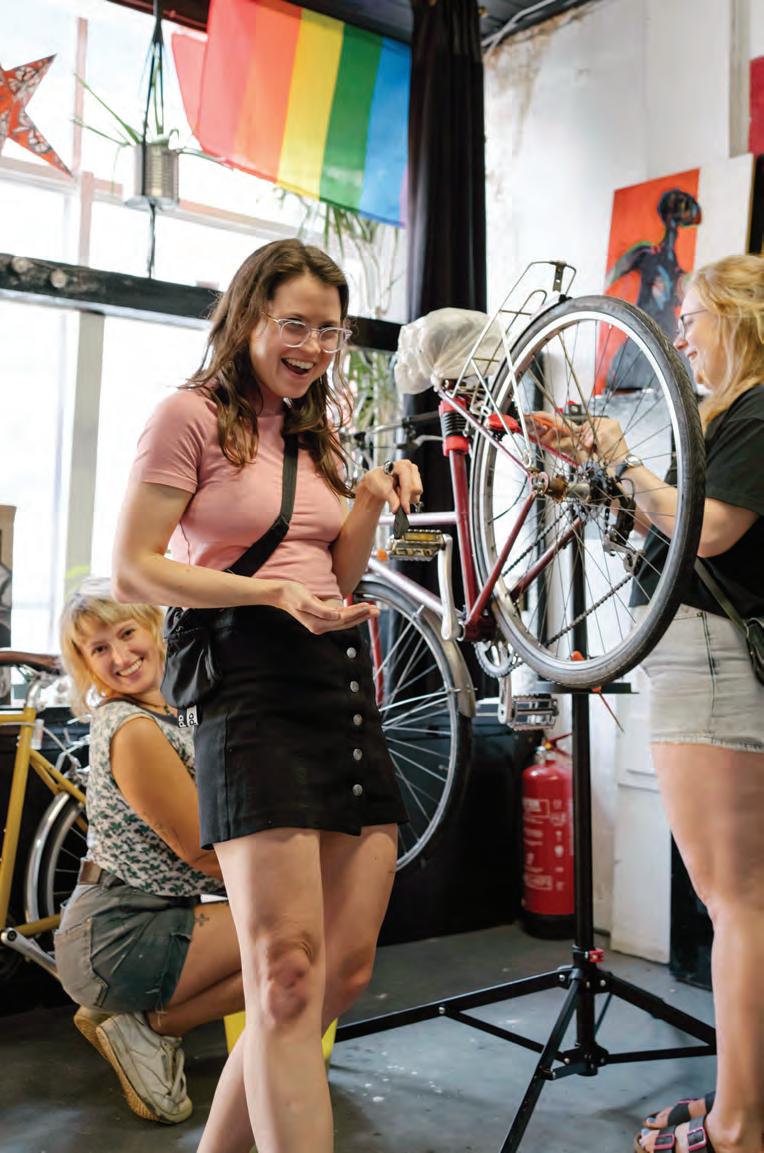

Name: Yunis Nazir Borough: Tower Hamlets
What’s the story behind TeamMC, and how did it all get started?
We started about eight years ago, as a small club in east London organising rides and events for the local Muslim community to help people begin cycling, all off the back of our founder becoming the first person to cycle from London to Mecca for Hajj.
It’s been slow growth since then, though recently we’re starting to see more of the community getting involved (though predominantly still men). However, we’re trying to break those barriers to get more women joining us on rides.
What have your personal highlights been so far with the group?
Just being able to empower people in our community to have that confidence to head out and cycle on their own. So many come to us not knowing anything about their bike, but after just a few classes and group rides they’re heading out and have the knowhow to stay safe.
What’s the main thing you’ll be using the Share the Joy funding for?
We really want to grow the number of Muslim women cycling. Share the Joy has allowed us to start putting funding towards female-only rides, by paying for women already riding with us, to take courses to become ride leaders. Understandably, many women feel more comfortable riding with a group of other women from a similar background, and Share the Joy is hopefully going to make that happen.
Are you able to see the impact of the funding yet?
For what we’re doing right now, it’s had a real impact: from paying for more local women to do ride leader courses, to covering costs in the workshop so we can get more people back on a bike, it’s been great to have.
It’s even gone into our events and group rides, so more young people from the south-Asian community see people like them on a bike and start to think about giving it a go themselves.
What would you say to other organisations that are thinking of applying?
Definitely apply. If it’s going to get more people on a bike, and seeing just how great for them it can be, then do it. Because if you get it, the impact can really do a lot for your community.
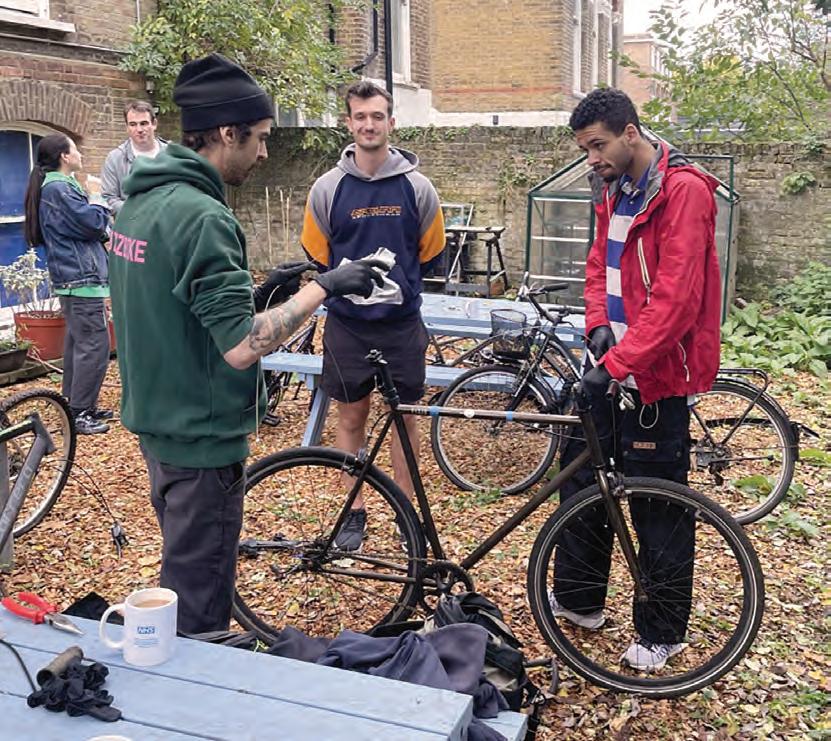
Name: Will Orr Ewing (sport coordinator) Borough: across London
Can you explain the background of Single Homeless Project and how things branched out into cycling? SHP started in 1975 when six homeless Londoners challenged the system to make their version of a safe place to live. They wanted to see an end to rough sleeping and a city where everyone has a safe place to call home. Our cycling project started in 2023, running bike maintenance workshops and cycle rides for adults living with severe mental health conditions. From there we’ve branched out to young people’s (YPs) services in Greenwich and Lewisham, where we’ve fixed up bikes that were abandoned in the garden.
Are you able to pick some personal highlights from your time being involved with SHP?
There are so many to choose from, but the two trips to Herne Hill velodrome with our young people were so much fun. Every time a client finishes building a bike is a great feeling too. Not only the accomplishment of having completed something that seemed so far out of reach, but when someone has so little it means so much giving them a bike.
What’s the main plan for the Share the Joy grant?
It’s already helped us with everything. In our bike mechanic workshops, we pay for freelance mechanics and every single bike part (and there’s lots needed when bikes have been sitting outside for years).
Plus, as mentioned earlier, the fund has also gone towards our cycling trips to Herne Hill. Both were massive successes and we’re hoping to do more in the future.
Can you tell us what the impact of the funding has been?
Well it just can’t be underestimated. Our clients feel part of something, building rapport with staff and their peers. Our cycling sessions have seen clients engage with a project where they haven’t ever engaged previously. This is a huge outcome, as some clients are really isolated. Our cycling workshops have helped to bring people together, reducing these periods of isolation and increasing social connection.
What would you say to other organisations thinking of applying?
Go for it! If you’ve got a project that can make a real difference, the funding can be a game-changer. For us, it helped bring our ideas to life, ideas that might not have happened otherwise. It gave us the support and confidence to try something new.
Name: Roo Haley (accessibility and inclusion officer) Borough: across London
What’s the story behind Queers on Wheels, and when did you start?
Queers on Wheels was founded back in 2021 by a small group of friends who had a passion for the outdoors and long-distance cycling. There were a few other LGBTQ+ cycling groups out there, but they were mainly for gay men. Plus it was difficult for many queer people to find a community and a safe space, especially for trans, non-binary people, or gender non-conforming people. So Queers on Wheels exists to bring all queer people together through a love of cycling.
What have been the highlights?
For me, each ride I go on always feels like the best one. A favourite would be one we did from London out to the Surrey Hills. In that kind of environment, you can have some lovely conversations with people, which is a big reason why I love what we’re able to do.
How will you be using the Share the Joy grant?
A real mix of things, from maintenance courses to the cost of train tickets for riders who might be struggling a bit with money. We’re also in the middle of planning a major bikepacking trip, so the funds are also going to go towards helping cover costs, to ensure as many as possible can share the adventure.
What’s the impact of the funding been so far?
It’s had a real impact. We’ve been able to pay for mental health training for some of the team. Many in the queer community are struggling now, and it’s something that I think we should talk about more, and as a group we’re better equipped to support them.
What would you say to other organisations thinking of applying? Just go for it. Keep it simple and keep in mind the community you’re serving.
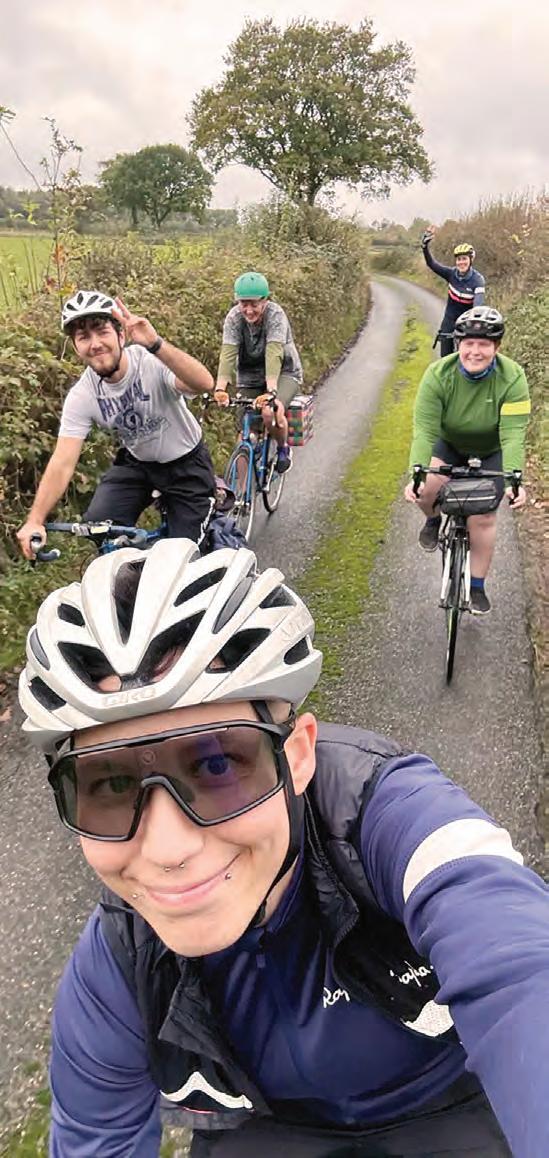
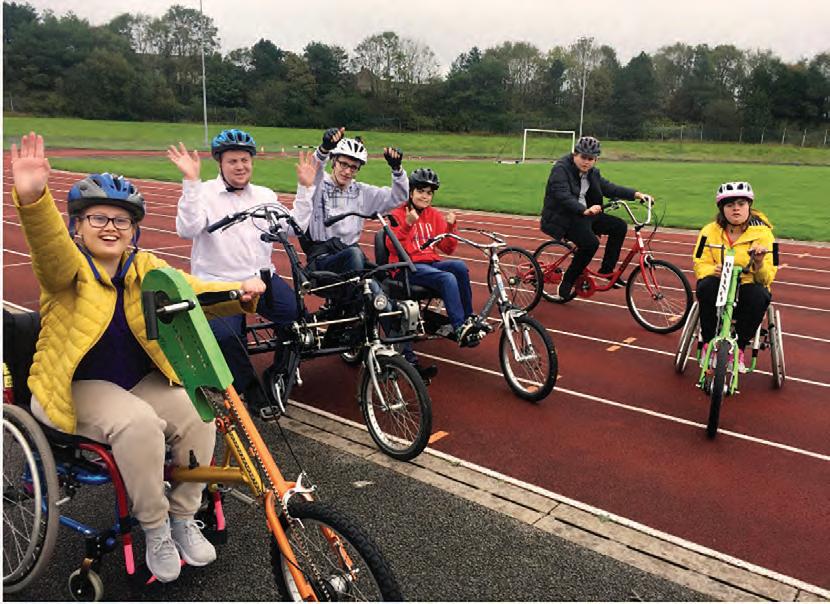
Name: Philippa Curphey (regional manager, south-east) and Simon Denton (Kingston coordinator) Borough: Kingston
What’s the history of Wheels for All?
We’re the largest provider of inclusive cycling in the country. We dream of a world where every disabled person and those with long-term health conditions can feel the exhilaration, joy and empowerment of cycling. Our Kingston hub opened in August 2022 and from the outset the demand was evident and we quickly became fully booked.
Can you describe some of your personal highlights to date?
It’s great when you build that rapport with a group. Our school group is mostly non-verbal, but you can see the enjoyment on all their faces, and the daycare centres like to have banter with our team. They ask ‘how many laps should I aim for?’ and it’s lovely to be
such a massive part of their week.
What are you using the Share the Joy funding for?
The fund is already helping us cover essential costs like ongoing cycle maintenance, which is vital for keeping our sessions safe, reliable, and accessible week after week.
It’s also enabled us to invest in our brilliant staff and volunteers by providing training in areas like first aid and bike maintenance. All of which allows us to keep running the sessions and helping whoever we can.
Are you able to see the impact the funding has had?
The Share the Joy fund has made a transformative difference to our inclusive cycling sessions. It has allowed us to offer more personalised support and welcome a wider range of participants each week.
The result of that is a professional
yet inclusive atmosphere where everyone feels valued — whether they’re trying cycling for the first time or rediscovering a passion they thought was no longer possible.
And what would you say to other organisations that might be thinking of applying to Share the Joy?
I’d highly recommend it. The Share the Joy grants have enabled real, inclusive change in communities. For smaller organisations or grassroots groups thinking about applying, it can be a game-changer.
If you’re doing something that brings people together and makes a difference, this fund can help you take it further.
Any organisation which has a great idea and has already started to flesh it out, I think go for it and I think that’s exactly the type of projects that Share the Joy excels at funding. It’s been a catalyst to help bring our ideas to life.


Tom Bogdanowicz looks at the latest cycle theft stats and asks what can be done to turn the tide.
(ADDITIONAL RESEARCH BY BRITT WARBURTON)
SUPPORTED BY: KRYPTONITE

BIKE THEFT IN London is like a “hole in the cycling growth bucket”.
So says London’s walking and cycling commissioner, Will Norman. He says a stolen bike means 15% of victims stop cycling; 20% stop temporarily and 27% cycle less.
Widespread cycle theft in London undermines mayoral targets to increase active travel and encourage cycle use. According to the Met Police, reported thefts number 16,000, but unreported thefts could be two to three times that, and bikes stolen in burglaries could add another 9,000 (according to officers a quarter of burglaries include bike thefts), making a total of some 70,000 thefts per annum. That is almost 200 bikes stolen per day. In addition, bike jackings (cycles taken by force from riders), an even greater deterrent to cycle use, occur at a rate of two per day according to the Met’s data.
Cycle theft in broad daylight is not uncommon, and thieves have good reason to think that they will get away with it — the police crime dashboard shows that of 16,104 reported thefts in 2024 there were only 192 outcomes. That’s just over 1% of reported stolen cycles recovered or thieves identified.
A 2021 TfL survey found fear of theft was the third biggest barrier to cycling (after road danger and personal safety) for 66% of noncyclists and 75% of cyclists.
In recent years the thieves’ task has been made easier by the advent of portable angle grinders which can easily cut cheaper D-locks and chains quickly. Lock makers now make angle-grinder resistant locks, but they are costly.
LCC has spoken to both the
Met and TfL about the pernicious impact of cycle theft and cycle muggings. Until mid-2024 there was a multi-organisation ‘crime reduction partnership’ — including TfL, LCC, the Met, and the cycle industry — with the task of addressing cycle theft, but it was suspended before taking action.
LCC plans to renew its call for action to be taken on cycle theft in early 2026. The new initiative — to be supported by lock brand Kryptonite — will propose a series of recommendations for London. These are summarised below and will form part of a more detailed report on what must be done to tackle this damaging crime.
In 2010 Mayor Boris Johnson set up a cycle taskforce with a brief to reduce cycle theft by 10% in 12 months. The team achieved its target, but was then disbanded. Under Mayor Sadiq Khan the ‘cycle crime partnership’ came and, regrettably, went. TfL/Met must provide resources for a new anti-theft taskforce, including an online team, with a target of reducing reported and actual cycle thefts by 10% in 12 months.
Understanding the scale of cycle theft and its patterns can help tackle the problem. Gangs, for example, can be a key factor in some areas: in the City of London arresting a single gang led to a fall from 68 thefts in a month to 19. House burglaries could be a factor too, so could the ease of selling stolen bikes online.
We need to know who steals bikes, which bikes are targeted (are step-through frames less vulnerable, for example?), which

locks best deter theft, which locations are a focus, when do thefts happen, how are thieves disposing of the bikes and what impacts theft has on cycle use?
The analysis must include mugging, burglary, distribution of incidents, participation of gangs, theft of cycle parts, stolen sales hotspots, online marketplaces (Facebook, Gumtree, eBay, Craigslist, etc), number of investigations, arrests, and convictions. Partners in any cycle theft action group could assist with such highly useful data collection
A universal nationwide cycle marking and registration scheme could make the resale of stolen bikes much more difficult, at least within the UK. France has launched such a scheme mandating all cycles sold, whether new or used, must be registered on the national database. Indications are that it is helping to reduce theft.
Police mark bikes, using Bike Register, at many events organised by LCC local groups and by TfL. Registration is free, though the marking and stickers are paid for unless supplied by the police. The catch is the scheme is not mandatory, shops are reluctant
to allocate the time to mark bikes they are selling, and the scheme, as yet, does not verify the identity of the person registering the bike — even though they could be an untraceable thief under an assumed email (an update now means you can check when a bike was registered). Bike Register says it has nearly 1.5 million bikes registered, which compares to some 30 million cycles owned in the UK.
Traceability of a cycle encourages honest sales and deters the handling of stolen property. If all cycles changing hands were marked, buyers could be more confident that they are dealing with an honest seller. This could be reinforced by retailers only servicing marked cycles, and secure cycle parking compounds for marked cycles. Bike Register points out that universal marking would also make recovery and enforcement easier.

The Dutch answer to cycle theft is to makes sure bikes aren’t easily stolen on the street: they provide controlled-access cycle compounds at stations and city centres. Those in Amsterdam and Utrecht have capacity for thousands of bikes and the first 24 hours of parking is free. The Dutch also install compounds at popular tourist destinations like Leidseplein in Amsterdam.
Whether it’s at home, at destinations, or at transport hubs, in London we have insufficient secure cycle parking. TfL’s Cycle Parking Action Plan (2019) estimated an immediate need for at least 36,000 bike spaces at stands and pointed out that TfL had an estate of 5,700 acres, including car parks, some of which could be allocated to cycle parking.
A study by Clean Cities in 2024 found that 60,000 people were on waiting lists for (paid for) spaces in cycle hangars (lockable on-street cages for bikes). And TfL said that “out of the 516 stations audited outside Zone 1 in 2015, 339 do not meet the new (TfL) benchmark for cycle parking”. Given the current lack of capacity, commercial operations can charge £50 a month for secure parking.
The answer is simple: provide more secure (lockable) cycle parking at stations, key destinations, workplaces and where people live. Local authority, NHS and company (including rail operators) policies invariably back active travel, so let’s deliver more secure cycle parking. And buildings with unused cycle parking spaces should sublet those to neighbours who need them.
All too often, unwitting Londoners buy cheap locks and/or secure cycles poorly. Trade association
Sold Secure rates locks from bronze to diamond in terms of resistance to theft attacks. In London silver grade is considered the minimum deterrence, yet the average lock sold at nationwide retailer Halfords is bronze rated, while online, cheap ineffective cable locks proliferate.
The messaging must be ubiquitous and clear:
n Use a top-grade lock,
n Adopt good locking technique,
n Register the bike,
n Note the frame number,
n Photograph the bike,
n Add distinguishing marks,
n Never buy a stolen bike.
Cycle theft is fuelled by those who deliberately or inadvertently purchase stolen bikes. For buyers, asking the seller for credible ID and purchase receipt is an obvious first step, along with checking the bike frame number against the (limited) stolen cycle listing on Bike Register.
Stolen bikes, especially ones made from stolen parts to disguise their origin, can be dangerous to ride; they can also be identified by the owner and seized; they can be ineligible for insurance; and a shop may identify them as stolen and report them or refuse to service them. These risks of buying stolen should be communicated via all online sales channels.
Police officers say that cycle theft is seen by professional criminals as

an entry-level activity that can be assigned to young men.
City of London police have conducted operations in which cycles are fitted with electronic trackers. These ‘bait bikes’ trapped thieves who were stealing cycles in volume — thefts in the City fell significantly after the arrests.
The City of Cambridge police force reports a 35% reduction in cycle theft over three years by a combination of education on locking, follow-up on CCTV evidence, cycle marking and criminal behaviour orders (CBOs) to ensure that individuals were riding a cycle they owned.
Online marketplaces are a primary sales outlet for stolen cycles and components. The owners of these marketplaces should help deter theft, and protect their reputation, by providing clear information on how to avoid buying stolen and referring suspect items to police.
A new anti-theft taskforce must establish a code of practice for shops, online marketplaces and other retailers who sell secondhand goods — no servicing of unmarked bikes; no purchase
of unmarked bikes; sellers to secondhand shops to be authenticated/photographed. Online marketplaces must provide warnings and actively prevent stolen sales.
A code of practice for cycle shops offering used bikes for sale was pioneered in Amsterdam and then a similar approach was trialled in the borough of Haringey.
The principle is that shops agree to a code that stipulates that they will not handle or service stolen bikes. Cycle shop staff can ask for ID and, if suspicious, check frame numbers against existing lists of stolen bikes. Branded e-bikes often have QR codes or numbers on both frame and motor and are not easily home-serviced.
Those with more expensive cycles sometimes install GPS trackers, or use devices like Airtags (Apple) and Tiles (Android).
While crowd-sourced intelligence can help identify the location of a stolen cycle it still has to be followed up for recovery, either by the police or an appointed agent. Experience suggests that it is rare for police to do this, but private recovery firms such as Pedalback have recovered expensive cycles.



To transform London’s active travel potential needs bold, radical ideas and this thread of LCC’s Dare to Dream campaign is just that, as Jessica Pike explains
In the spring issue of London Cyclist, we asked: ‘What if every Londoner had a bike?’
It’s a question that has elicited some strong reactions, inevitable when putting forward bold asks, and people have queried its necessity. But just like the myth of never being more than six feet away from a rat anywhere in the city, isn’t every Londoner also supposed to be within tripping distance of a poorly-parked hire
bike? Surely anyone who wants to cycle will find a way to do so?
We assessed this carefully before including an ask about increasing access to cycling in our Dare to Dream campaign and the truth is, no, not everyone who wants to cycle can find a way to do it.
The biggest barrier to more Londoners cycling is a network of safe, direct cycle routes, but it’s not the only barrier. Some people can’t afford a bike and if you’re
unemployed or self-employed, Cycle to Work schemes aren’t even an option. If your pay is low, sacrificing more of your salary will take you below minimum wage, unthinkable in the current economic climate.
Then there’s the storage issue. Bike theft is rampant in London so if you don’t have secure outdoor storage or live with people forgiving of a bike in the hallway, is your faith in a D-lock big enough to justify the cost of a new bike? Hire bikes can help but they don’t cover the whole of London yet and the cost can be prohibitive for people who are unemployed or on low incomes. And what if you’re Disabled and need to try out a variety of cycles to find the right one for your needs? Or you’re a parent who needs a cycle that can fit your kids and the weekly shop? And where do you park these often larger non-standard cycles?
We think it’s time the Mayor of London did more to address these barriers. This could look like ramping up the expansion of secure cycle parking, providing easier access to non-standard cycles, creating a Cycle to Work alternative, or even hire bike credits for Londoners who would benefit from them the most.
So back to the original question, what if every Londoner who wanted a bike could have access to one? With the help of brilliant organisations across the capital, this became the reality for some Londoners and we hope you’ll be inspired by their stories.
As we progress our Dare to Dream campaign, you can find out more at: lcc.org.uk/dream.

We met David through his involvement in the Jessop Primary School dads and male carers club — an initiative that’s received a Share the Joy community grant — where men can spend quality time with their kids, connect with one another and be role models for positive masculinity. A father to twins, David’s also a charity worker, supporting families with sick children in hospital.
David used to own a road bike, but when that was stolen he thought owning one had become a thing of the past. But he now has a brand new e-bike to get around on, thanks to the friendly staff at Trek, who also offered him helpful advice about insurance and security.
Joshua is 24 years old, lives in north-west London and works as a paralegal. When he’s not deep in his work, Joshua likes to spend his spare time going on hikes and playing badminton. On a trip to Amsterdam, Joshua was inspired by their cycling culture and thought he’d love to see something similar in London.
The place where Joshua lives lacks secure cycle parking so he’s been getting around on a Lime bike, which gives him the freedom to get from A to B without having to worry about whether his bike would be safe locked up outside or not.
Using a Lime bike has made things more convenient and accessible for Joshua, even giving him that extra push to get to the gym on lazy days. By cycling more regularly, he can feel himself getting fitter and he’s getting to see more of the city too.
Hire bikes are a godsend for people who don’t have a place at home where
David is loving being back on a bike he can call his own again. Considering he’s based in Feltham, having electric assist from the e-bike helps with his long commute and getting across to other areas of London. Cycling is saving him money on transport, improving his fitness and he’s noticing mental health benefits too. He’s also been exploring new areas thanks to the bike.
Despite all these positives, a lack of safe storage options means he has to keep the bike inside and if there are lift outages, he has to lug the heavy bike up multiple stairs. Bike ownership becomes more appealing when there are adequate safe storage options.
they can safely leave or lock up a bicycle, but not everyone can afford them. More employees should have access to hire bike credits, either through expenses, a modified Cycle to Work scheme, or as a greener alternative to a company car. And for Londoners out of work or on low incomes, we need programmes that ensure cheap or free access to hire bikes.

Jemma is a social media manager based in Forest Gate and has cycled in London for over 15 years. She’s comfortable cycling on the roads but has found it scarier mixing with traffic when she’s got her two boys on the bike. She’s been getting around on a heavy nonelectric Dutch-style bike equipped with two childseats, but as her children have grown older, it’s become more challenging. She also tried out a trailer, but the boys are starting to outgrow that too and she likes them being in a position where she can easily see them.
Enter London Green Cycles. Originally based in Camden, they now have a Wandsworth store as well and offer cargobike sale, hire and repairs. The team is clued up, friendly and has lent Jemma an electric cargobike. Buying a cargobike

can be a big investment, so having the option to hire them first is invaluable in helping people make informed decisions. Jemma is loving the box bike, using it to get the kids to nursery, do food shops, pop in at a plant sale and load up the kids’ bikes so they can cycle at the

We were introduced to Mishkat through upCYCLE, an organisation addressing the lack of diversity in London’s cycling community, by creating a fun and inclusive environment for young people from ethnic minority groups to share their passion for cycling.
A dedicated student rebuilding her life in the UK, Mishkat was given a refurbished bike through upCYCLE, something that would have been difficult for her to access on her own due to financial constraints. She was also taught how to repair a puncture, helping
velodrome. Her partner has also jumped in on occasions! This kind of hauling would’ve been plain impossible on her standard bicycle.
More cargobike loan programmes will ensure that people who need to carry large loads can still do so by cycle.
her become more self-sufficient with basic repairs.
In between her academic demands, she’s been building up her cycle confidence over the past year. Mishkat started off with little cycling experience, but with a confident, can-do attitude, she’s been learning to ride on the roads and has even tackled some off-road trails in Richmond Park.
Organisations like upCYCLE play a vital role in ensuring that people who might otherwise have not been given the opportunity to cycle are equipped to do so. And along with ensuring organisations like these get the funding they need to deliver their important work, we also need more options for cash-strapped students to get a bike. This could take the form of a longerterm, lower repayment level Cycle to Work alternative run by the Mayor of London and London boroughs, so that students, people who are self-employed, working part-time or on lower incomes have access to pedal-powered wheels.

Susie’s journey into cycling began when she wanted to fundraise for brain tumour research. Instead of a walking pack, she was mistakenly sent a cycling pack, so decided to challenge herself, get a trike and cycle 274 miles in a month.
She now works as a cycling instructor at Wheels for Wellbeing, a charity that enables Disabled people to access the benefits of cycling.
Disabled people face more barriers when trying to access cycling — and even when those who need a nonstandard cycle are able to traverse the high costs involved, narrow cycle lanes, a lack of dropped kerbs, TfL’s ban on nonfolding e-bikes and more present a hostile environment for Disabled cyclists.
Through Wheels4Me London, an
inclusive cycle loan scheme, Susie was able to find the right cycle for her needs, enabling her to move around independently, crisscrossing the streets of south London and further afield to get between her home, inclusive cycling sessions, appointments and meeting up with friends.
Having a try-before-you-buy scheme like Wheels4Me London is great, but there’s a lot more work that can be done to enable more Disabled people to cycle. Cycle to Work should be expanded to enable access to a wider range of cycles on a payback loan or other basis, along with a roll-out of personal charging points for electric cycles and secure cycle storage for nonstandard cycles.
Piers lives in Ladbroke Grove and is a DJ and director at Portobello Radio, a community radio station. He’s clearly become a fixture in this part of London, often taking a beat to acknowledge or say hello to someone he knows.
Having cycled in London since his late teens, Piers found himself cycling less and less as he got older, and an accident and a bike that had seen better days almost brought his riding to a halt.
Through Peddle My Wheels’ trybefore-you-bike scheme, Piers has been able to get on a reliable bicycle and, with the scheme’s flexible one-month rolling subscription, he’ll have the option to buy the bike outright at a reduced cost over time.
He can cycle over to Stamford Bridge to catch Chelsea playing and get to DJ gigs, even when they’re on the other side of London. He’s loving being able to cycle again and has noticed his fitness, lung capacity and mental health improving. Having had a heart attack a few years ago, he’s also keen



on doing longer rides to improve his cardiovascular fitness.
Such try-before-you-bike schemes help ease or offset the normal upfront costs associated with bicycle ownership,
Marya works part-time as a teaching assistant for children with special needs and lives in Tooting. Seeing her on a bike, you would never guess that she only learnt to cycle last year at the age of 32. Cycle Sisters — an award-winning charity that empowers Muslim women to cycle by creating supportive, womenonly spaces — got her pedalling, but she wasn’t sure if she was ready to commit to getting a bike of her own.
Like Piers (above), Marya was also introduced to Peddle My Wheels’ try-before-you-bike scheme and has been able to test out a folding bike in a risk-free way, with cycling accessories included. Without secure outdoor storage or an adequate storage space indoors, the folding bike has been
though currently not every borough in London offers them. Where boroughs are falling short, we want the Mayor to step in to ensure every Londoner has this sort of access.
Tracey’s love of cycling began when she was a child, whizzing off on a bike without stabilisers while her dad was teaching her older sister how to ride. This love continued into her adult years until health challenges forced her to put the brakes on cycling.
In another success for Peddle My Wheels’ trial scheme, Tracey has been able to try out an e-bike on a monthly rolling contract and has found that the electric assist and step-through frame has helped her to get back in the saddle.
Based in Lewisham, Tracey recently visited studios in Deptford for London Gallery Week and the e-bike helped her easily move between venues. And it’s not just the mobility boost that Tracey has enjoyed, she’s also been able to go cycling with friends and feels more connected to London’s growing community of cyclists.
The try-before-you-bike scheme has been invaluable for Tracey, getting her one step closer to figuring out which bike suits her needs. It can take time for people to find ‘the one’ which is why schemes like this and Wheels4Me London are so important.
perfect for Marya’s needs and she’s even given it a British Asian name: Alexandra Chandni. Without a car, Alexandra Chandni is enabling Marya to get around more independently and speed up her journeys — just what every timepressed parent needs.
Cycling has been great for Marya’s mental health, bringing more focus to her ADHD brain and it’s created more opportunities for play, racing her two children on their scooters in the cul-desac near their home.
Marya just loves the feeling of cycling now, something all LondonCyclist readers will understand. So if you want more people in the capital to enjoy the amazing benefits that cycling offers, find out more at lcc.org.uk/dream
But even when people find the right cycle it might be unaffordable, which is why there needs to be better funding options for people who need more than just a bog-standard bike.
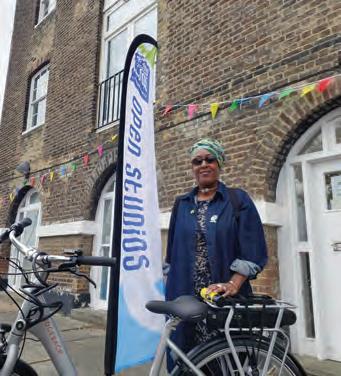
Whether it’s longer commutes, the school run, shopping or recreation, there’s an electric bike to suit your needs...

BENNO BOOST
The Benno Boost, built with ‘e-tility’ design, carries over three times the load of a standard bike. Powered by a Bosch mid-drive electric motor and dual battery option, it offers an impressive 160 miles of range. An interchangeable rack and rail system allows dozens of accessory configurations to fit any lifestyle or mission, while the Boost’s rigid aluminium frame, 24in custom
tyres, and upright riding position provide power, comfort, and control — even under heavy loads or in tough conditions. Whether used by rescue teams, couriers or suburban explorers, this awardwinning bike delivers unmatched versatility and performance for adventures close to home or off the beaten path. n £3,499.99 to £6,199.99; ison-distribution.com

As its name suggests, the Errand lives up to its name as your perfect do-it-all transport solution. Commute, shop, or enjoy a coffee run with ease, thanks to its agile 20in wheels and chunky tyres built for urban streets. Its compact frame suits riders from 5ft to 6ft4in, making it ideal for the whole household. Powered by a 250W Promovec hub motor, with 54Nm of torque and a simple display, you get smooth power delivery for you and your cargo, tuneable via the smartphone app. Hydraulic disc brakes, an 8-speed Microshift drivetrain, neatly integrated AXA lights, full mudguards, and a sturdy front rack ensure the Errand carries everything you need, every day.
n £1,799.99; freewheel.co.uk
TENWAYS AGO AIR
Compact but powerful, the Raleigh Modum is built to move through the city with ease. With 20in wheels, a lightweight frame and twist-to-store handlebars, it’s easy to ride, carry and stash in tight spaces. With a Bosch Performance Line motor and 500Wh battery, it packs serious power. Add in hydraulic disc brakes, hub gears and up to 70 miles of range from the battery, and it’s ready for anything.
Thanks to a range of compatible accessories, the Modum can be transformed into a cargobike in minutes — ready to carry smaller pets, business supplies, or even your big weekly shop. Then, when the load is lighter, simply turn it back into your trusty everyday bike — easy!
n £1,999.99; raleigh.co.uk
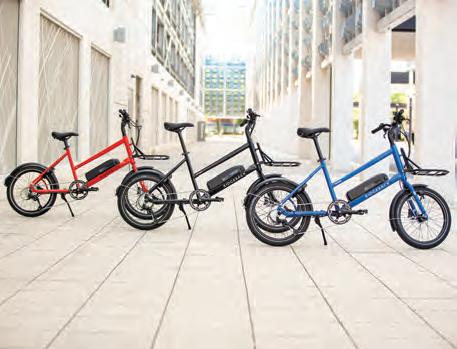
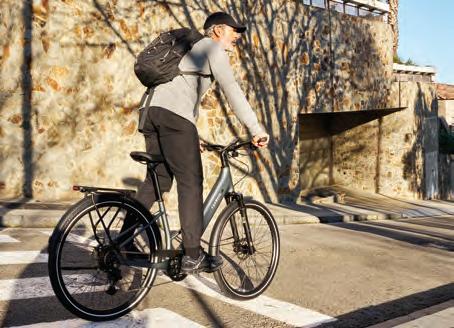
Tenways AGO Air is sleek and agile, but with loads of practical features. It’s also probably Tenway’s most capable ‘all-rounder’ as it blends impressive mid-drive motor climbing power, off-road capable tyres, front suspension and hard-wired lighting. Add in a strong rear rack, tough alloy mudguards and wide-ranging e-bike specific Shimano Cues gearing and you can see why the ‘do-it-all’ epithet is so apt.
Tenways’ own brand motor is rated at a punchy 80Nm of torque and the 560Wh capacity battery offers a range of up to 60 miles — meaning it’s a great bike for longer weekend leisure rides in hillier terrain, as well as standing up to the rigours of all-year round commuting. Three colour options available.
n £2,199; uk.tenways.com
The award-winning Tern GSD is now in its third generation and has become a hugely popular sight on UK streets. Capable of carrying three passengers (one adult and two small children) and with a gross vehicle weight of 210kg, the Tern GSD is the more efficient alternative to a minivan. From the school run to the weekly shop, the GSD is compatible with dozens of specifically-designed accessories, so you can easily personalise it to your exact needs; choose from seats, chairs, trays, racks and more.
Powered by a reliable Bosch motor and finished with high quality components, the GSD also offers the ability to run twin batteries, making a total range of 120 miles possible — all in comfort and safety.
n From £5,000; ternbicycles.com/uk


Advance by name, advanced by nature. The Ridgeback Advance 3 is your gateway to local roads, trails and towpaths, powered by the Shimano STEPS E6100 drive unit for seamless pedal assist over climbs. A sleek, hidden 504Wh battery delivers a massive 205km range potential, more than enough for weekend tours. The Microshift 10-speed gearing ensures you’ll find the right gear for any terrain, while hydraulic disc brakes deliver confident stopping power. Bump-munching comfort and grip is handled by the RST suspension fork and 50mm Schwalbe G-One tyres. Integrated lights, full wraparound metal mudguards, and the neat AtranVelo pannier rack system complete a build that’s as adventure-ready as they come. n £3,799.99; freewheel.co.uk
Only just launched, the Raleigh ONE is set to become a new icon in urban mobility, blending classic design with cutting-edge tech. Built for simplicity, with one size and one gear, it’s powered by a low-maintenance motor and belt drive, with up to 80km range. This ‘connected’ e-bike is also leading the way on security features: it includes app-enabled GPS tracking, theft alerts, and automatic unlocking (via a unique code). An integrated rear light is paired with a dual-front light, while adjustable handlebars let you tailor your riding position. The ONE delivers on reliability, backed up by a comprehensive dealer network, and fully integrated app — unlocking a plethora of smart capabilities. Available in off-white or sage green. n £2,399; raleighbicycles.com
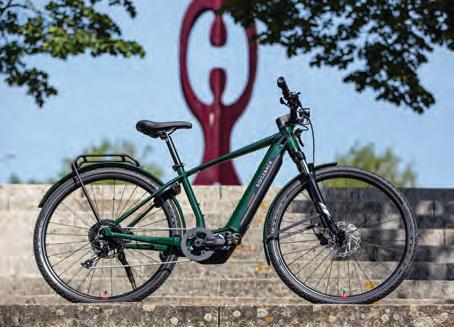

THE CYCLING team at Osbornes Law recently represented a cyclist who suffered serious injuries following a collision with a car. He was on his way home from work, when the car hit him as he was crossing a slip road.
The cyclist suffered very serious injuries to the head, a fractured knee, punctured lung, fractured clavicle, injuries of the spleen and kidney, and a fractured finger. While in hospital he was admitted to intensive care for a lengthy period following a cardiac arrest.
On being instructed, Andrew Middlehurst immediately began negotiations with the driver’s insurance company to secure private rehabilitation for the cyclist, including a physiotherapist and psychologist. And to better understand the long-term impact of the injuries sustained, examination by a top knee
With decades of expertise, Osbornes Law makes cyclists’ claims its priority
was arranged. Other medical assessments were being made when the insurers made an early six-figure offer of settlement. To fully evaluate this offer, a barrister from a leading Chambers was asked to consult on the case and provided further tactical advice.
Despite the limited available medical evidence, the cyclist was given thorough advice on the risks involved and the different aspects of valuing a claim such as his, including compensation for his injuries, out of pocket expenses and future financial losses.
With the benefit of that extra advice, a settlement was reached soon afterwards allowing the case to
be closed less than 18 months after the collision.
The cyclist commented: “I’m incredibly grateful for the support I received from Andrew at Osbornes. He guided me through every step of the process and made sure I had access to the care and advice I needed. The collision turned my life upside down, and at times I didn’t know what the future would look like, but the settlement has given me peace of mind and the ability to focus on my recovery.”







We're not sure there's many finer rides in London, than this one exploring parks, stately homes and riverside pubs. Charlie Codrington guides the way...
F YOU THINK a good gravel ride is about challenging climbs and chasing your heart rate, think again. This 26-mile off-road loop through south-west London is less sufferfest, more period drama on wheels. We're talking grand palaces, whispered scandals, deer-dotted parks, riverside views, endless pubs, and wonderful smooth trails.
Linking six of London’s finest green spaces and numerous stately homes, this isn't just a bike ride, it's a rolling time capsule, serving up history, beauty, and just the right amount of weirdness. You’ll pass secret gardens, forgotten canals, ancient towpaths and scenes of bucolic rural bliss — all without leaving the city.
Whether you're a Londoner looking for a fresh way to see your own backyard, or visiting and craving something better than a cramped tour bus, this one’s for you.
The ride begins with a gentle roll past the now-silent Stag Brewery, dropping you straight onto the Thames Path. It’s a peaceful stretch along the river, with woodland on one side and water on the other. Expect herons keeping watch and flocks of rowers battling the tide. Before long, you’re cruising under the green iron arches of Hammersmith Bridge. Designed by polymath and sewer genius Joseph Bazalgette, it’s one of the oldest suspension bridges in the
START/FINISH: Mortlake station
DISTANCE: 42km (26 miles)
ELEVATION: 200m (600ft)
SURFACES: roads, gravel paths, towpaths park trails, cycleways.
BEST BIKE: anything with decent tyres. TOP TIP: each historic house is worth exploring inside; check opening times online and explore fully.
world — and now only accessible for cyclists and pedestrians.
Kudos to Hammersmith & Fulham Council for opening the cycle route along the north bank. It’s a delightful network of winding paths and twisting alleys, each revealing a handsome pub or charming café every hundred metres.
Take care crossing the busy Burlington Lane before entering the formal oasis of Chiswick Park, birthplace of the English Landscape Movement and inspiration for Blenheim Palace and New York’s Central Park. It’s a place that invites you to slow down and soak it all in. While you're at it, spare a thought for Georgiana, Duchess of Devonshire; a socialite, fashion icon, political player, and compulsive
For hassle-free navigation, let Beeline show you the way. Plan quiet routes, follow them with ease, and record all the fun — Beeline is a cycling device that will change how you ride your city. Visit beeline.co for more info.
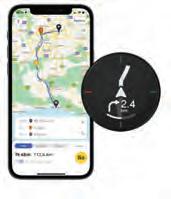
gambler, whose wigs were often taller than your front door and occasionally featured tiny ships. Seriously. Next cross Kew Bridge into Brentford, where new bike lanes lead you past the Water & Steam Museum and into the industrial-era landscape of Victorian wharves along the Grand Union Canal. There’s the occasional wiggle or hike-a-bike step, but it’s worth it.

Then, bam, you’re suddenly in Syon Park, and the vibe shifts again. Once home to a strict abbey (until Henry VIII did his thing), legend has it his bloated corpse exploded here en route to Windsor. The monks called it divine justice. Today, Syon House is a stunner: Robert Adam interiors, Capability


Brown gardens, and a greenhouse that’s part jungle, part jewel box. Or follow the trail through manicured pastureland dotted with grazing cows.
Following the Thames upstream brings you to Marble Hill House, once home to Henrietta Howard, George II’s mistress and a savvy operator who turned hush money into a riverside retreat that became a hub for writers and thinkers like Pope and Swift.
Next stop is Orleans House, former home to exiled French aristocrats, now a beautiful gilded gallery with an excellent café tucked into the stables.
4
From there, the road leads you to Strawberry Hill House, which looks like a Transylvanian castle designed on a sugar high. Built by Horace Walpole (yes, Prime Minister, Gothic novelist, and avid collector of oddities), it’s delightfully strange in the best possible way. You’ll want to stop and explore.
Things get greener again as you roll into Bushy Park, with red deer acting like they own the place (they kind of do). Cobbler’s Walk takes you straight down Chestnut Avenue, past a gilded statue of Diana surrounded by water nymphs, four small boys, and seashells. At the end is the grand Lion Gate to Hampton Court Palace.
Slip through a side gate into Home Park, a true hidden gem. There’s a narrow path here you may want to walk. But the payoff is a jaw-dropping view of Wren’s Baroque facade framed by Tudor towers, with swans drifting down the Long Water. And, best of all, it’s often completely empty.
Cross Kingston Bridge, then take a short detour through the medieval streets to Clattern Bridge. Built in the 12th century, it’s the oldest bridge in London still carrying traffic — this one over the Hogsmill River.
And then it's Richmond Park. Join the gravelled Tamsin Trail and exit via Ham Gate. Cruise across Ham Common, then turn into the grand avenue up to Ham House.
Duchess Elizabeth Murray lived here during the Civil War and apparently left behind... vibes. Screams, cold spots, invisible dogs, the lot — read up on it!
Quickly you rejoin the Thames towpath, via Petersham Marshes. Then it's a final climb up to Richmond Park via Sheen Gate, and a coast into Mortlake.
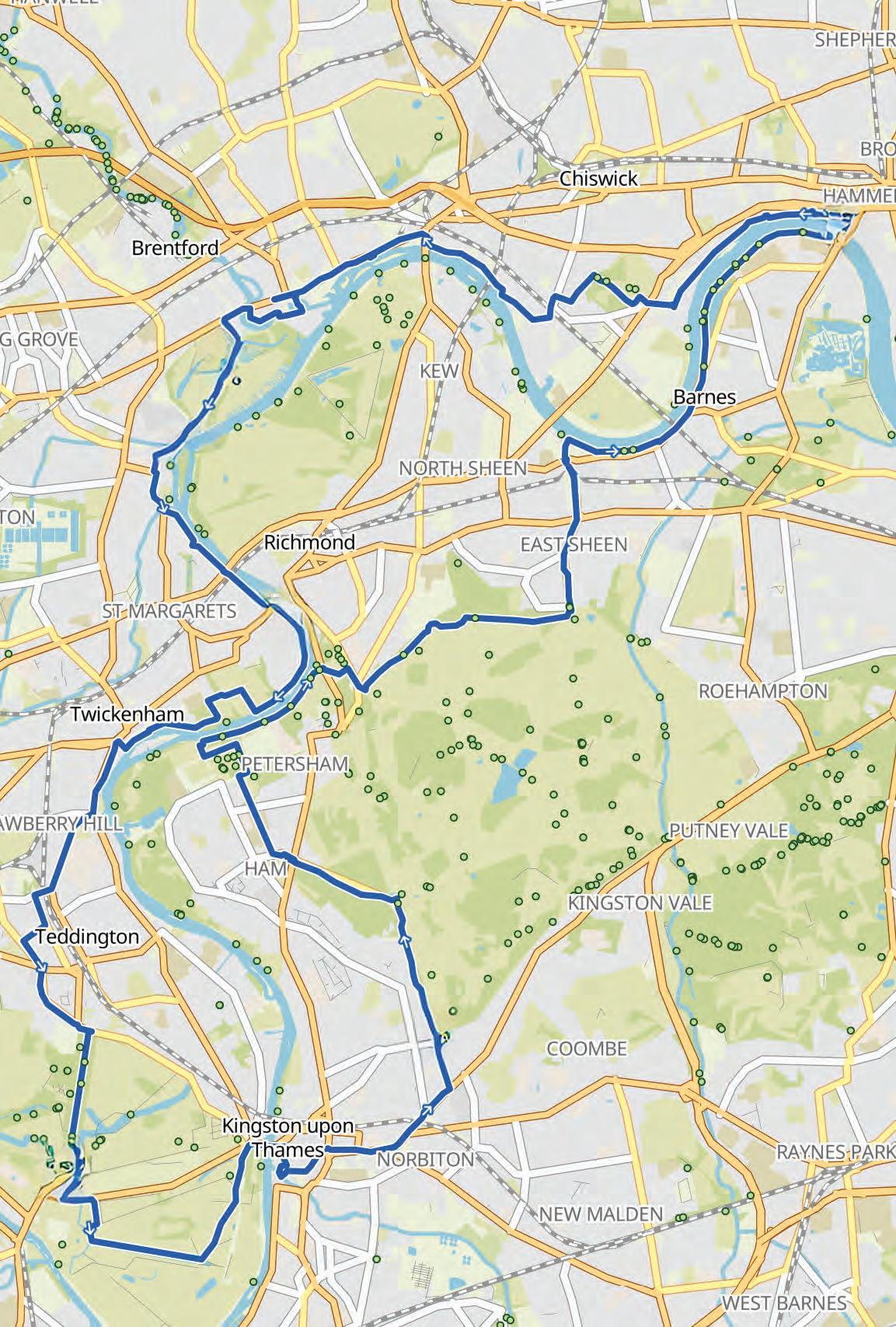

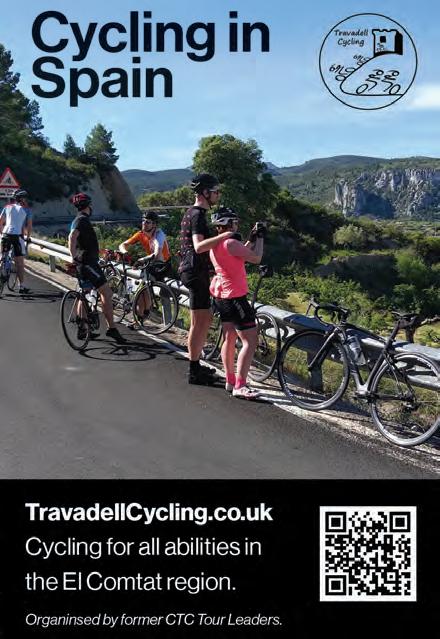

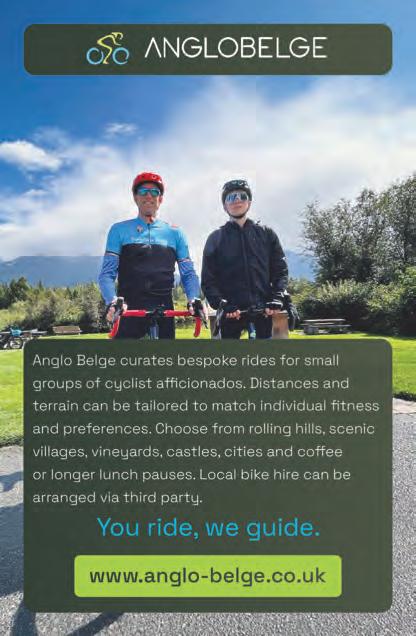
Ask most cyclists which maintenance task gets them most flustered and it’s invariably adjusting the gears. And even with electronic shifting and single chainrings (no front derailleur) simplifying the overall job, there’s still several key points to undertake to ensure smooth rear gear shifting. So we got the team from Fettle (fettle.cc), experts in faff-free bike repair, to pass on all the tips you’ll need.

1. ARE YOUR GEARS SKIPPING OR JUMPING?
If your gears aren’t shifting smoothly it can be for several reasons, including a wonky derailleur hanger, worn cassette or chain, or stretched gear cable. Here we focus on bikes with mechanical shifting. Indexing simply means adjusting the rear derailleur so the guide pulley lines up exactly with each cassette cog during shifting.

2. GET TOOLED UP
You’ll need a way to lift the rear wheel (eg a workstand), and a screwdriver and/or hex keys for the adjustments, depending on the model. But before starting it’s best to clean the drivetrain as residue and grime can mask or worsen shifting issues. So have some degreaser, a clean rag and a suitable chain lubricant ready too.

3. CUT THE SLACK
Cables can slacken over time. If your indexing has become imprecise, it’s good to start with re-tensioning. So shift to the smallest cassette cog, loosen the cable anchor bolt,
pull the cable taut by hand, then re-tighten the bolt. Pro tip: first set your barrel adjuster about three-quarters of the way in, this gives you room to reduce tension too.

4. FIND YOUR LIMITS
Shift into the smallest cog (and smallest front chainring if your bike has two). Locate your derailleur’s limit screws — usually marked ‘L’ (low) and ‘H’ (high). Adjust the ‘H’
screw so the guide pulley sits directly beneath the smallest cog. Then shift to the largest cog; adjust the ‘L’ screw to align the pulley and prevent overshifting into the spokes.

The barrel adjuster finetunes cable tension: turn this anti-clockwise to increase tension (easier upshifts) or clockwise to reduce it (easier downshifts). Shift up one
gear at a time and observe. If the chain hesitates, skips, or doesn’t land cleanly, make quarter-turn adjustments. Test across multiple cogs, shifting up and down.

Once you’re happy and have spun through all the gears with the bike in the workstand, go riding and shift up through every rear gear and back down under a light
load. Listen for ticking, delays or skipping. Tweak the barrel adjuster slightly if needed. But work in small increments to avoid overcorrecting — patience pays off here!


Even perfect indexing can’t fix worn components. Use a chain wear indicator tool to check for stretch, and regularly inspect the derailleur for loose pivots
or a bent derailleur hanger. Replace worn parts promptly; a stretched chain will cause premature drivetrain wear. Regular care ensures crisp shifts and parts last longer.
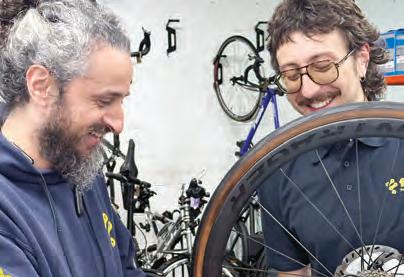
While some bicycle repairs may seem daunting, others are more easy to master (including gear adjustments). Remember we all started with limited know-how and
it takes a while to learn how everything works. Ask friends, search online tutorials, or visit your local independent bike shop for advice. Before long you’ll have new life skills!

THE LOAD4 75 is one of four larger capacity front-loader cargobikes from German manufacturer Riese and Müller, with the ‘75’ referring to the length of the loading surface (75x54cm); the shorter, similarly-specced Load4 60 is £200 cheaper. R&M also makes the more compact Carrie, with prices starting at £4,719. These are all very high-end bikes and the pricing does reflect that, so we appreciate that it won’t be a realistic option for everyone; but as more of us look for versatile alternatives to owning a car, the Load 75 and its stablemates are likely to become more commonplace on London streets.
The Load 75 can carry up to 70kg on a cargo bed that sits relatively


low to the ground, which we found made the bike feel super stable to ride even when fully laden. The cargo area can be configured to carry up to three young kids in seats with belts — two facing forward and one facing back — or with different boxes and covers. We opted for a more conventional carrying set-up and left the optional side walls in situ.
It’s also one of the only fullsuspension e-cargobikes available — note the Suntour fork up front with 80mm of travel and the X-Fusion coil shock at the rear — and this pairing, in tandem with the chunky Schwalbe tyres, did an amazing job at soaking up all the lumps and bumps we encountered, from potholes to cobbles. We noticed



immediately how much the jarring and juddering from uneven surfaces was absorbed; for a bike of this size it really is extremely comfortable to ride. Plus the seatpost and stem are easily adjustable to fit a good range of rider heights.
A Bosch Cargo Line motor provides the pedal assistance, while a 14-speed Rohloff belt-driven hub gear gave us silky smooth changes when needed. The single 725Wh battery provided more than enough range for multiple trips in and around town in one day. The control unit and display are easy-to-use and need to be paired with Bosch’s app if you want to customise the riding modes, plan routes, or access security features that can disable the
motor when it’s not connected to your phone by Bluetooth.
Further security comes from an Abus rear wheel lock, and a neat, additional chain that plugs into the wheel lock and stows in the saddle bag provided. We didn’t consider those secure enough for London so also used diamond-rated Kryptonite products at all times.
n One size fits all, covering a range of riders from 1.5m to 2m in height.
n Seven build options, including derailleur gears, Enviolo 380 hub or Rohloff E-14 hub (as tested, £8,729).
Higher spec means higher price.
n Frame uses 25% recycled aluminium.


The tech/security does mean it takes longer to get organised before setting off; and you need plan trips and stops more fully. We found space to park securely in the bike room at LCC HQ, but storage in smaller spaces would be a challenge. It’s a sizeable commitment in more ways than one, so buyers must be really sure a bike this big’s what they need.
+ Extra-large capacity cargobike that’s really enjoyable and comfortable to ride.
+ Suspension is huge plus point.
+ Diamond-rated locks a must.
+ Storage space can be an issue.
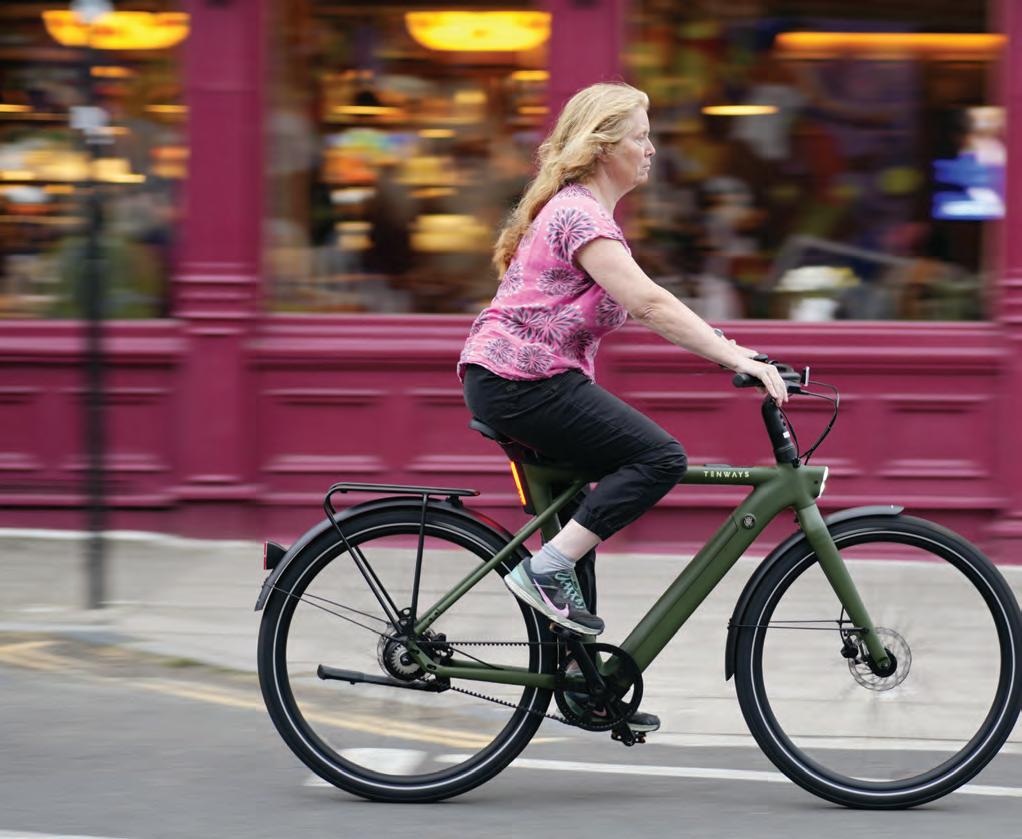
WITH ITS army green finish and sharp geometry, allied to a smooth, stable ride and upright cycling position, the new Tenways e-bike does make you feel that a smart city uniform is a far better match than Lycra.
We’ve been impressed by the Netherlands-based brand’s bikes tested previously and this new CGO009 has a look that evokes both the famous GT Bicycles ‘triple triangle’ design and the industrial feel of VanMoofs. The fine frame detailing and immaculately neat weld areas remain, and reliable componentry like Tektro disc brakes and a singlespeed Gates belt drive are included. Using belt drive means minimal maintenance and an


end to greasy chain marks on your clothing (a ‘bashguard’ around the chainring also comes as standard). Contact points like saddle (Selle Royal), handlebars and grips add a touch of urban cool to the mix.
A rear hub motor provides the pedal assistance and helps power the bike up to the legal limit of 25kmph (15.5mph), and we found that pedalling support seamless and predictable on flat and moderate inclines. On our more challenging off-road test up to Ally Pally, we had to resort to zigzagging to maintain momentum, though on the paved and seriously steep (13%) Uplands Road it made it to the top easily despite the lack of gears. We should stress that Tenways does not



recommend the CGO009 for ‘offroad’ use, but we found towpaths and parkland trails to be fine.
Accessories like a kickstand, pannier rack and full mudguards are included, along with a lockable and removable battery; this allows for charging indoors even if the bike is stored outside. According to Tenways the 374Wh battery offers a range of 85km on a full charge and our consumption was roughly in line with that. Both front and rear lights are elegantly integrated into the toptube and a minimalist bar-mounted controller looks after all the electric functions.
Encouragingly, Tenways is not shirking its security duties either — download the Tenways smartphone
app and you can use the GPS tracking feature (the bike comes with three years’ tracking for free), which enables you to spot where your child or friend has gone cycling on it or, if stolen, where a thief has taken it — it’s a great idea. Even without the mobile connection, we were still able to use the push-button controls on the bars to set the pedal assist
n One size and three colours available.
n Integrated tracking feature.
n Lockable, removable battery.
n Neat tool kit included.
n One-piece handlebar and stem limits adjustability.
n No bottle cage mounts.

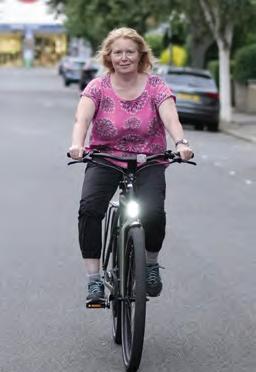
mode. Also, by popping your phone into the dedicated stem mount, you can get a live data dashboard (showing range and typical ride metrics) or follow simple route navigation prompts.
If the sizing works for you, there’s not much we’d change, and we’d certainly recommend the CGO009 for hard day-to-day use.
+ Stylish e-bike that undercuts key rivals on price.
+ Distinctive design.
+ Very capable on the flat and on moderate hills.
+ Tenways CGO800S is lighter and cheaper.
Words: JK, Jon Callard
Mixing news and reviews on the latest cycle-related products, including innovative tech, must-have accessories and recommended reads
As you'll have read on page 36 of this magazine, cycle theft is still on the rise across the UK, with more than 200 bikes being stolen every day across London. And while LCC and others put pressure on the Mayor, TfL and Met Police to adopt stronger measures to counter this crime, we'll continue to urge cyclists everywhere to use the best locking practice possible. Sold Secure gold-rated D-lock and cable combinations like the K-Traz U17 cover most bases; the 14mm steel shackle is large enough to secure frame and rear wheel to a variety of stands, and a 120cm cable ensures front wheels aren't left as easy targets for opportunist thieves. A simple-to-fit mount means you can carry the lock on your bike, plus there's three keys supplied as standard. This is a high level of deterrence at a very decent price. n £49.99; chickencyclekit.co.uk



The changing of the seasons means one thing for cyclists — it's time to get into winter mode. On go the mudguards, out come the waterproof jacket and trousers, and the search begins for the lights and charging cables you last saw six months ago. If you've decided it's time to upgrade the latter, or the rear light specifically, we've been using the Mid Cobber for a while now and been pleasantly surprised by its lengthy run time between charges (up to 100hrs on 'eco flash' mode). There's actually eight solid, pulsing or flash modes to choose from, the brightest kicking out 170 lumens, though we often defaulted to 'disco flash' (80 lumens) as it lasted fine for 3hr+ night-rides. Most impressive feature, however, is the curved design of the lamp body which not only sits neatly against seatposts, but offers 330-degrees of visibility — that's potentially the best side illumination we've ever seen. A USB connector is tucked away safely beneath the rubber strap. n £62.99; knog.com
For decades children's cycle helmets were little more than basic, one-size-fits-all affairs with poor padding and few features. Thankfully these days brands are trickling down the tech from their adult ranges to those aimed at infants; Met has half-a-dozen models in its kids' line-up and even the shape and silhouettes mimic the mum and dad models. The Hooray comes in Mips and non-Mips versions — Mips being the inner cradle which protects against rotational impacts — with ten vents to keep heads cool, antipinch buckles, fontanel protection, and washable comfort pads. Plus there's 11 fun colours to choose from, including forest (above) and green fruit (right). n £39.99-£75; extrauk.co.uk

If you've read our book review pages in the past you'll be familiar with Vertebrate Publishing's extensive list of titles covering all types of cycling: from mountain biking and leisure riding to road and, more recently, gravel biking. This latest guide follows the same format as the earlier ones (Peak District, Lakes District, etc), but the focus here is on the stunning trails in and around the national park and Grampian Mountains. Graded from easy to challenging, all 15 routes include map, navigational info and scene-setting photos. Having ridden a trio of these loops ourselves in perfect, midge-free weather this spring, we feel duty-bound to nudge you northwards too, it's arguably the best, wildest 'proper gravel' in Britain. n £15.95; adventurebooks.com





























“Osbornes Law took on my case after I was hit by van on my cycle to work. I learnt about them as a member of the London Cycling Campaign. I would recommend Osbornes Law to anyone who is unsure how to proceed following a traumatic cycling accident.”

Felicia D













Few, if any, bicycles have the aesthetic beauty of the Superb, suggests John Kitchiner. It’s just a crying shame that production never ran smoothly...

THERE’S SOMETHING about classic curvy, chromed cruisers that’s so embedded in Americana that they immediately fire the nostalgic imagination and send you back to a very specific time in history. A time of rock ‘n’ roll, jiving, baseball jackets, and ‘duck’s arse’ pompadours. Spot a curvy Schwinn, Monark, Huffy or Columbia in the wild and the associated 1950s cultural touchstones come flooding in.
Schwinn is generally credited with developing the first cruisers back in the 1930s, taking design cues from motorbikes the company had previously built, featuring ‘cantilevered’ frames with twin toptubes and 2in-wide ‘balloon’ tyres; later models added the faux ‘gas tank’ and even a batterypowered headlight. Other manufacturers soon joined the fray as popularity soared, though production came to an abrupt halt thanks to the bombing of Pearl Harbour and the USA’s involvement in the Second World War.
For the same reason Columbia’s Superb never quite made it off the drawing board when it was conceived and only survives in concept form and as a limited number of special
editions. What a thing of beauty it was though — with a chromium-plated dashboard housing an odometer, clock and speedometer; swooping rear rack with integrated light; and that rocketship-styled front lamp.
In 1952, to celebrate Columbia’s 75th anniversary, the company produced a 5-Star Superb in stunning green and white livery (including colour-matched mudguards) and a coilsprung front fork. Due to their rarity, this remains among the most sought-after models by cycle collectors worldwide.
Inspired by Columbia’s approach to integration, rival Huffy went on the create the quite brilliant RadioBike which, as the name suggests, placed a transistor radio and speaker in the outsized gas tank, with a battery pack to the rear.
And while Superbs and other original cruisers are now very hard to find, due to their indestructible nature (they weighed a tonne) thousands were reborn thanks to the young Californian ‘Repack’ riders who stripped them down, and added derailleurs and assorted touring/tandem parts to race them down the trails of Marin County — and in the process creating one of the origin stories of mountain biking.

